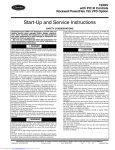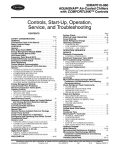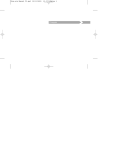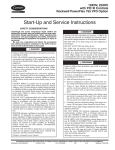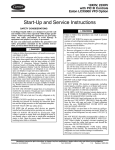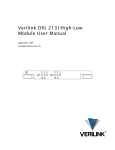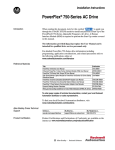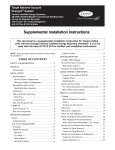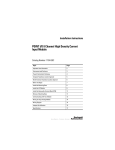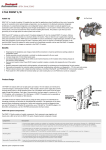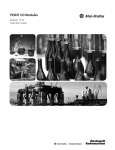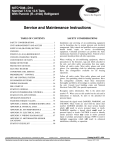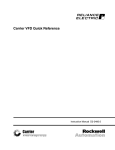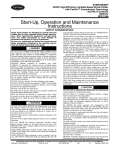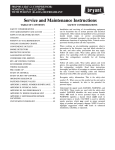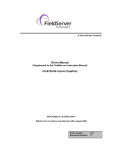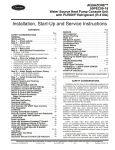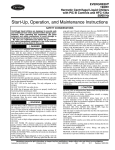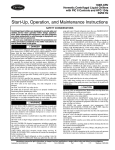Download Start-Up and Service Instructions
Transcript
19XRV, 23XRV with PIC III Controls Rockwell PowerFlex 755 VFD Option Start-Up and Service Instructions SAFETY CONSIDERATIONS Centrifugal and screw compressor liquid chillers are designed to provide safe and reliable service when operated within design specifications. When operating this equipment, use good judgment and safety precautions to avoid damage to equipment and property or injury to personnel. Be sure you understand and follow the procedures and safety precautions contained in the chiller instructions as well as those listed in this guide. DANGER Failure to follow these procedures will result in severe personal injury or death. ONLY QUALIFIED electrical personnel familiar with the construction and operation of this equipment and the hazards involved should install, adjust, operate, or service this equipment. READ AND UNDERSTAND this manual and other applicable manuals in their entirety before proceeding. Failure to observe this precaution could result in severe bodily injury or loss of life. DO NOT install modification kits with power applied to the drive. Disconnect and lock out incoming power before attempting such installation or removal. Failure to observe this precaution could result in severe bodily injury or loss of life. UNUSED WIRES in conduit must be grounded at both ends to avoid a possible shock hazard caused by induced voltages. Also, if a drive sharing a conduit is being serviced or installed; all drives using this conduit should be disabled to eliminate the possible shock hazard from cross-coupled motor leads. Failure to observe these precautions could result in bodily injury. DO NOT VENT refrigerant relief valves within a building. Outlet from rupture disc or relief valve must be vented outdoors in accordance with the latest edition of ANSI/ ASHRAE 15 (American National Standards Institute/ American Society of Heating, Refrigerating, and Air Conditioning Engineers). The accumulation of refrigerant in an enclosed space can displace oxygen and cause asphyxiation. PROVIDE adequate ventilation in accordance with ANSI/ ASHRAE 15, especially for enclosed and low overhead spaces. Inhalation of high concentrations of vapor is harmful and may cause heart irregularities, unconsciousness, or death. Misuse can be fatal. Vapor is heavier than air and reduces the amount of oxygen available for breathing. Product causes eye and skin irritation. Decomposition products are hazardous. DO NOT USE OXYGEN to purge lines or to pressurize a chiller for any purpose. Oxygen gas reacts violently with oil, grease, and other common substances. (Dangers continued in next column.) DANGER NEVER EXCEED specified test pressures, VERIFY the allowable test pressure by checking the instruction literature and the design pressures on the equipment nameplate. DO NOT USE air for leak testing. Use only refrigerant or dry nitrogen. DO NOT VALVE OFF any safety device. BE SURE that all pressure relief devices are properly installed and functioning before operating any chiller. THERE IS A RISK OF INJURY OR DEATH by electrocution. High voltage may be present on the motor leads even though the motor is not running. Open the power supply disconnect before touching motor leads or terminals. WARNING Failure to follow these procedures may result in personal injury or death. DO NOT USE TORCH to remove any component. System contains oil and refrigerant under pressure. To remove a component, wear protective gloves and goggles and proceed as follows: a. Shut off electrical power to unit. b. Recover refrigerant to relieve all pressure from system using both high-pressure and low pressure ports. c. Traces of vapor should be displaced with nitrogen and the work area should be well ventilated. Refrigerant in contact with an open flame produces toxic gases. d. Cut component connection tubing with tubing cutter and remove component from unit. Use a pan to catch any oil that may come out of the lines and as a gage for how much oil to add to the system. e. Carefully unsweat remaining tubing stubs when necessary. Oil can ignite when exposed to torch flame. DO NOT work on high-voltage equipment unless you are a qualified electrician. DO NOT WORK ON electrical components, including control panels, switches, VFD, or oil heater until you are sure ALL POWER IS OFF and no residual voltage can leak from capacitors or solid-state components. LOCK OPEN AND TAG electrical circuits during servicing. IF WORK IS INTERRUPTED, confirm that all circuits are de-energized before resuming work. AVOID SPILLING liquid refrigerant on skin or getting it into the eyes. USE SAFETY GOGGLES. Wash any spills from the skin with soap and water. If liquid refrigerant enters the eyes, IMMEDIATELY FLUSH EYES with water and consult a physician. (Warnings continued on next page.) Manufacturer reserves the right to discontinue, or change at any time, specifications or designs without notice and without incurring obligations. Catalog No. 04-53190027-01 Printed in U.S.A. Form 19/23-4SS Pg 1 4-13 Replaces: 19/23-2SS WARNING CAUTION DO NOT ATTEMPT TO REMOVE fittings, covers, etc., while chiller is under pressure or while chiller is running. Be sure pressure is at 0 psig (0 kPa) before breaking any refrigerant connection. USE only repair or replacement parts that meet the code requirements of the original equipment. PERIODICALLY INSPECT all valves, fittings, and piping for corrosion, rust, leaks, or damage. DO NOT re-use compressor oil or any oil that has been exposed to the atmosphere. Dispose of oil per local codes and regulations. DO NOT leave refrigerant system open to air any longer than the actual time required to service the equipment. Seal circuits being serviced and charge with dry nitrogen to prevent oil contamination when timely repairs cannot be completed. CAUTION Failure to follow these procedures may result in personal injury or damage to equipment. TO AVOID an electric shock hazard, verify that the voltage on the bus capacitors has discharged completely before servicing. Check the DC bus voltage at the power terminal block by measuring between the +DC and -DC terminals, between the +DC terminal and the chassis, and between the -DC terminal and the chassis. The voltage must be zero for all three measurements. THE USER is responsible to conform with all applicable local, national, and international codes. Failure to observe this precaution could result in damage to, or destruction of, the equipment. THIS DRIVE contains ESD (electrostatic discharge) sensitive parts and assemblies. Static control precautions are required when installing, testing, servicing or repairing this assembly. Component damage may result if ESD control procedures are not followed. For static control procedures, reference Rockwell publication Guarding Against Electrostatic Damage, or any other applicable ESD protection handbook. DO NOT alter the setting of any jumper. Failure to observe this precaution could result in damage to, or destruction of, the equipment. USE OF power correction capacitors on the output of the drive can result in erratic operation of the motor, nuisance tripping, and/or permanent damage to the drive. Remove power correction capacitors before proceeding. Failure to observe this precaution could result in damage to, or destruction of, the equipment. MOST CODES require that upstream branch circuit protection be provided to protect input power wiring. If fuses are chosen as the protection method, refer to the PowerFlex 750 user manual. Failure to observe this precaution could result in damage to, or destruction of, the equipment. DO NOT route signal and control wiring with power wiring in the same conduit. This can cause interference with drive operation. Failure to observe this precaution could result in damage to, or destruction of, the equipment. DISTRIBUTION SYSTEM short circuit capacity shall not exceed the rating of the drive. Failure to observe this precaution could result in damage to, or destruction of, the equipment. DO NOT STEP on refrigerant lines. Broken lines can whip about and release refrigerant, causing personal injury. DO NOT climb over a chiller. Use platform, catwalk, or staging. Follow safe practices when using ladders. USE MECHANICAL EQUIPMENT (crane, hoist, etc.) to lift or move inspection covers or other heavy components. Even if components are light, use mechanical equipment when there is a risk of slipping or losing your balance. BE AWARE that certain automatic start arrangements CAN ENGAGE THE VFD, TOWER FAN, OR PUMPS. Open the disconnect ahead of the VFD, tower fans, or pumps. (Cautions continued in next column.) CONTENTS Page SAFETY CONSIDERATIONS . . . . . . . . . . . . . . . . . . . . 1,2 INTRODUCTION . . . . . . . . . . . . . . . . . . . . . . . . . . . . . . . . . . 2 ABBREVIATIONS AND EXPLANATIONS . . . . . . . . . . 3 Required Publications . . . . . . . . . . . . . . . . . . . . . . . . . . . . 3 Getting Assistance from Rockwell Automation . . . 3 IDENTIFYING DRIVE COMPONENTS . . . . . . . . . . . 3-6 Opening the VFD Access Door . . . . . . . . . . . . . . . . . . . 3 Drive Assembly Catalog Number . . . . . . . . . . . . . . . . . 4 Components and Physical Data . . . . . . . . . . . . . . . . . . 4 START-UP . . . . . . . . . . . . . . . . . . . . . . . . . . . . . . . . . . . . . . 7-9 Alternate Wire Lugs . . . . . . . . . . . . . . . . . . . . . . . . . . . . . . 7 Verify Installation. . . . . . . . . . . . . . . . . . . . . . . . . . . . . . . . . 7 Configure the VFD. . . . . . . . . . . . . . . . . . . . . . . . . . . . . . . . 8 Commissioning the Unit. . . . . . . . . . . . . . . . . . . . . . . . . . 8 Check Internal Jumpers . . . . . . . . . . . . . . . . . . . . . . . . . . 8 SERVICE . . . . . . . . . . . . . . . . . . . . . . . . . . . . . . . . . . . . . 10-30 Troubleshooting the Drive . . . . . . . . . . . . . . . . . . . . . . . 10 • ICVC ALERT CODES • ICVC ALARM CODES • TEST EQUIPMENT NEEDED TO TROUBLESHOOT • VERIFYING THAT DC BUS CAPACITORS ARE DISCHARGED • HIGH TEMPERATURE ALARMS • MAIN CONTROL BOARD (MCB) COMPONENTS Checking Power Modules and Motor Input with Input Power Off . . . . . . . . . . . . . . . . . . . . . . . . . . 23 Servicing the Drive . . . . . . . . . . . . . . . . . . . . . . . . . . . . . . 24 • REMOVING THE DRIVE • RIGGING THE ENCLOSURE • REPLACING THE GATEWAY (A-B20-750-20COMM OPTION CARD) • CHILL PLATE FAN AND INTERNAL FAN REPLACEMENT Parts Identification and Location . . . . . . . . . . . . . . . . 27 APPENDIX A — WIRING SCHEMATICS . . . . . . . 31-34 APPENDIX B — BACNET COMMUNICATION OPTION . . . . . . . . . . . . . . . . . . . . . . . . . . . . . . . . . . . 35-41 INTRODUCTION The Carrier VFD option Start-Up and Service Manual is intended for trained and qualified service personnel, and is to be used during start up, operation, and maintenance of Rockwell/ Allen-Bradley PF755L drive. 2 ABBREVIATIONS AND EXPLANATIONS IDENTIFYING DRIVE COMPONENTS Frequently used abbreviations in this manual include: CCM DC DPI ENET ICVC IGBT I/O IP IPWM MCB MOV PE SIO STS VFD — — — — — — — — — — — — — — — A chiller control schematic and a VFD schematic are included in Appendix A. Chiller Control Module Direct Current Drive Peripheral Interface Ethernet International Chiller Visual Controller Insulated Gate Bipolar Transistor Inputs/Outputs Internet Protocol Inverter Pulse Width Modulation Main Control Board Metal Oxide Varistor Protective Earthing Conductor Sensor Input/Output Status Variable Frequency Drive WARNING DC bus capacitors retain hazardous voltages after input power has been disconnected. After disconnecting input power, wait five (5) minutes for the DC bus capacitors to discharge and then check the voltage with a voltmeter rated for the DC bus voltage to ensure the DC bus capacitors are discharged before touching any internal components. Failure to observe this precaution could result in severe bodily injury or loss of life. An isolated multimeter will be needed to measure DC bus voltage and to make resistance checks. The drive’s DC bus capacitors retain hazardous voltages after input power has been disconnected. Required Publications — The Carrier VFD option Start-Up and Service Manual must be used with the following manuals: • Latest version of the PowerFlex 755 AC Drives manuals • Latest revision of the Start-Up, Operation, and Maintenance Instructions for the 19XRV or 23XRV with PIC III Controls Opening the VFD Access Door WARNING Getting Assistance from Rockwell Automation — Contact the local Rockwell Automation sales office Before removing the drive enclosure, open access door and verify that the DC bus voltage has dropped to zero by checking the terminals behind the access door. Failure to observe this precaution could result in severe bodily injury or loss of life. with any questions or problems relating to the products described in this manual. For technical support on drives, call the HVAC Hotline at 1-888-926-6786, Option 1. Before calling, have the following information available from the Allen-Bradley data nameplate located inside the enclosure on the right wall. See Fig. 1. • Allen-Bradley ID or CAT. NO. • Carrier VFD Code • Allen-Bradley serial number 1. Using recommended screwdriver = 6.4 mm (0.25 in.) flat or T20 star, open access door. See Fig. 2. 2. Check to be sure that the voltage between DC+ and DCand from each DC terminal to the chassis is zero before proceeding. See Fig. 3. ID No.: 21P-104773-40 Input Rating: 480VAC 454A 60Hz 3PH Output Rating: 0-460VAC 477A 0-325Hz 3PH Max. Ambient Temperature: 40°C Short Circuit Rating: 65kA, 480V Max. Interrupt Capacity Rating: 100kAIC Enclosure Type: TYPE 1 Coolant Type: Refrigerant R134a Design Pressure: 185 PSIG Carrier Part Number: 19XVR0445335A1F VFD Serial Number: XXXXXXXXX Carrier Dwg. Number: 19XV04021001 Mfd. On: 08-13-10 ORDER NO: 0001772838-00001 FAC.LOC.: 1100 Fig. 1 — Allen Bradley Data Nameplate A19-1830 Fig. 2 — Opening Access Door A19-1831 3 1 L1 L2 L3 Drive Assembly Catalog Number — See Fig. 4 for an example of the Rockwell Automation Drive Assembly Catalog Number. I LOCKOUT/TAGOUT Components and Physical Data — The 19XRV chillers use the Allen-Bradley PF755 Frame 6 drive for the 230-amp rated application (Carrier Part No. 19XVR0230...). See Fig. 5. The Allen-Bradley PF755 Frame 7 drive is used for the 335-amp and 445-amp rated application (Carrier Part No. 19XVR0335... and 19XVR0445...). See Fig. 6. See Fig. 7 for the dimensions of Frames 6 and 7 for 19XRV chillers. The 23XRV chiller uses the Frame 7 drive for 335-amp and 455-amp rated applications (Carrier Part No. 23XVR0335... and 23XVR0445...). Frame 6 is not used. See Fig. 8 for the dimensions of Frame 7 for 23XRV chillers. O 2 DC BUS TEST TERMINALS LOCATED INSIDE ACCESS DOOR DC+ DC– 0V 0V MULTIMETER Fig. 3 — Check DC Bus Terminals A19-1814 21P - 1 0248 21P 3 - 3 0 PF755 VFD Voltage Rating 1 – 460 to 480 v, 60 Hz 2 – 380 to 415 v, 50 Hz 3 – 380 to 400 v, 60 Hz 4 – 401 to 439 v, 60 Hz Meter Package 0 – No Meter Package 2 – Digital Meter Package Disconnect/Breaker Options 3 – 65 KAIC Capacity Breaker 4 – 100 KAIC Capacity Breaker PF755 Full Load Amp Rating (Maximum Continuous Amps)* 0248 – 248 0361 – 361 0477 – 477 Drive Assembly 3 – Unit Mount NEMA 1 Liquid Cooled 4 – Unit Mount NEMA 1/IP 23 Liquid Cooled * For Carrier applications, maximum continuous amp ratings are 230, 335, and 445. Fig. 4 — Rockwell Automation Drive Assembly Catalog Number Nomenclature 4 LEGEND NO. 1 2 3 4 5 NAME Power Terminals PE Grounding Studs DC Bus and Brake Terminals PE-A and PE-B DC+ and DC- A191832 DESCRIPTION R/L1, S/L2, T/L3, U/T1, V/T2, W/T3 Terminating point to chassis ground for incoming motor shield +DC, -DC, BR1, BR2 MOV and CMC Jumper Wires Bus Voltage Test Points A19-1833 LEGEND Fig. 5 — Frame 6 Drive Components NO. 1 2 3 4 5 NAME Power Terminals PE Grounding Studs DC Bus and Brake Terminals PE-A and PE-B DC+ and DC- DESCRIPTION R/L1, S/L2, T/L3, U/T1, V/T2, W/T3 Terminating point to chassis ground for incoming motor shield +DC, -DC, BR1, BR2 MOV and CMC Jumper Wires Bus Voltage Test Points Fig. 6 — Frame 7 Drive Components 5 54.00 50.00 REF 30.00 C L CL 36.00 REF 40.00 FRONT VIEW NOTE: Dimensions shown in inches. Fig. 7 — 19XRV Enclosure Dimensions — Frames 6 and 7 a19-2011 NOTE: Dimensions shown in inches. Fig. 8 — 23XRV Enclosure Dimensions — Frame 7 6 START-UP Record the following nameplate information: 1. From the Allen-Bradley nameplate (Fig. 1) located inside the VFD enclosure: a. Allen-Bradley ID or CAT NO. b. Allen-Bradley Serial Number c. Carrier Part Number 2. From the machine nameplete (Fig. 9) located inside the VFD enclosure: a. Chiller Serial Number b. Chiller Model c. Motor rated load amps d. Motor nameplate rpm e. Motor nameplate kW f. Motor nameplate voltage g. Inverter PWM (pulse width modulation) frequency h. Voltage 3. From the drive module label (Fig. 10) located on the drive module: a. Model or Cat. Number b. Serial Number 4. From the ICVC control panel screen: a. Carrier Part Number and Revision b. ICVC Software Number Rockwell PowerFlex 755 drive start-up must be registered on the Rockwell website. Rockwell Registration site URL: http://www.automation.rockwell.com/warp/default.asp. DANGER Internal components and circuit boards of the drive are live when the drive is connected to incoming power. Coming into contact with this voltage is extremely dangerous and will result in severe personal injury or death. The motor terminals U, V, W and the DC-link/brake resistor terminals B+/R+, R- are live when the drive is connected to incoming power, even if the motor is not running. Do not make any connections when the drive is connected to the incoming power. After having disconnected the drive, wait until the indicators on the keypad go out (if no keypad is attached see the indicator through the keypad base). Wait 5 more minutes before doing any work on drive connections. Do not even open the cover before this time has expired.. Before connecting the drive to the incoming power, make sure that the switchgear enclosure door is closed. WARNING The control I/O-terminals are isolated from the mains potential. However, the relay outputs and other I/O terminals may have a dangerous control voltage present even when the drive is disconnected from incoming power. Coming into contact with this voltage could result in severe personal injury. a191846 CAUTION If other than refrigerant cooling is used, before connecting the drive to the incoming power, make sure that the coolant is circulating and has no leaks. A United Technologies Company CAUTION MODEL NUMBER SERIAL NUMBER MACHINE NAMEPLATE SUPPLY DATA When working with the Drive Explorer, never use the Rotate function as the motor will immediately start and severe compressor damage could result. VOLTS/PHASE/HERTZ LOCKED ROTOR AMPS OVERLOAD TRIP AMPS MAX FUSE/CIRCUIT BREAKER SIZE MIN SUPPLY CIRCUIT AMPACITY Alternate Wire Lugs — In the case where the incoming MACHINE ELECTRICAL DATA power wire size does not fit the standard lug, alternate lugs may be used. See Table 1. Note that lugs rated for a higher current than the circuit breaker may be used. MOTOR NAMEPLATE VOLTAGE COMPRESSOR 100% SPEED RATED LINE VOLTAGE RATED LINE AMPS RATED LINE KILOWATTS Table 1 — Wire Lugs CIRCUIT BREAKER 65 KAIC (Standard) 100 KAIC (Optional) STANDARD ABB LUG STANDARD LUG CABLE RANGE MOTOR RATED LOAD KW MOTOR RATED LOAD AMPS ALTERNATE ALTERNATE LUG CABLE ABB LUG RANGE MOTOR NAMEPLATE AMPS MOTOR NAMEPLATE RPM MOTOR NAMEPLATE KW K6TJ (3) 2/0 - 400 MCM Verify Installation — Record K6TH the (2) 250 - 500 MCM following INTERTER PWM FREQUENCY job information: 1. Job Name 2. Job Number 3. City 4. State 5. Zip Code SAFETY CODE CERTIFICATION THE COMPRESSOR MOTOR CONTROLLER AND OVERLOAD PROTECTION MUST BE IN ACCORDANCE WITH CARRIER SPECIFICATION Z-420. 19XV05008701 REV. 3 Fig. 9 — Machine Nameplate 7 Commissioning the Unit — The commission procedure is as follows: 1. If the chiller has been stored outdoors, allow at least 24 hours room temperature stabilization prior to commissioning. Ensure any condensation that occurs as a result of the ambient temperature is allowed to evaporate. 2. Enter parameters in the VFD_CONF screen. 3. Install surge suppression devices if required. 4. Review the power wiring and grounding to ensure that it has been properly connected. 5. Visually examine the inside of the drive enclosure to: a. Look for signs of corrosion or moisture residue. b. Remove any dirt or debris. c. Make sure all vents are clear. 6. Apply power to the drive and take thermal measurements of the capacitor bank and power connections. Do this again before start-up. 7. Measure and record the incoming line voltage. Line-toline voltages should be balanced within 3% as calculated by Rockwell’s procedure below: Measure voltages phase-to-phase and phase-to-ground. a191924 Fig. 10 — Drive Module Label Vmax = Maximum measured phase-to-phase voltage (A to B, B to C, C to A) Vmin = Minimum measured phase-to-phase voltage Imbalance Calculation Formula Configure the VFD — All configurations required by the VFD are supplied by the ICVC through the VFD Gateway. 19XRV, 23XRV Std Tier VFD can operate with PIC III ICVC and above. Any configuration changes necessary and possible are made on the ICVC screens. A complete set of configurations is transmitted to the VFD each time the controls are powered up. The following is from the 19XRV, 23XRV PIC ICVC screen. Parameters in italics are to be entered or confirmed at start-up. Parameters in bold are to be changed only after consulting with Carrier service engineering. See Table 2. (VAB + VBC + VCA) 3 (Vmax – Vmin) x 100 Imbalance % = Vavg 8. Take a final thermal measurement of the capacitor bank and power after finalizing the installation to ensure all connections are good. 9. If a ground fault occurs, then do the following: a. Check for a ground in the motor or motor wiring. b. Check for damage to wiring insulation and that wiring is dry. c. Verify the motor wiring is separated from ground and there is no connection between phases. d. Check for failed IGBTs. 10. If an overcurrent fault occurs, then do the following: a. Check for excessive load and verify load limit settings on the ICVC. b. Check motor and wiring insulation. c. Check parameter settings on VFD_CONF screen in the ICVC. Vavg Table 2 — VFD Configurations PARAMETER Motor Nameplate Voltage Compressor 100% Speed Line Freq=60 Hz? (No=50) Rated Line Voltage* † Rated Line Amps* † Rated Line Kilowatts* † Motor Rated Load kW* Motor Rated Load Amps* Motor Nameplate Amps Motor Nameplate RPM Motor Nameplate kW Inverter PWM Frequency (0 = 4 kHz, 1 = 2 kHz) Skip Frequency 1 (Hz) Skip Frequency 2 (Hz) Skip Frequency 3 (Hz) Skip Frequency Band Line (Hz) Voltage % Imbalance Line Volt Imbalance Time (sec)† Line Current % Imbalance† Line Current Imbal Time (sec)† Motor Current % Imbalance Motor Current Imbal Time Increase Ramp Time (sec) Decrease Ramp Time (sec) Single Cycle Dropout (DSABLE/ENABLE) DEFAULT VALUE 460 Yes 460 200 100 100 200 100 3456 100 1 20.0 20.0 20.0 0.0 10 10 40 10 40 10 30 30 DSABLE = Check Internal Jumpers — On the Main VFD Control board there are two jumpers labeled J1 HARDWARE ENABLE and J2 SAFETY ENABLE. J1 should be removed and J2 should be in place. See Fig. 11. There are two jumper wires that connect a particular terminal to chassis ground. The MOV and AC EMI jumper should be connected to the PE-A terminal. The COMMON MODE CAPACITORS to GROUND jumper should be connected to a standoff rather than the PE-B terminal. Use the recommended tools as follows when connecting jumper wires in Frame 6 and in Frame 7: • Recommended torque (screws and nuts) = 1.36 N·m (120.0 lb·in.) • Recommended hex socket = 7 mm • Recommended screwdriver = T20 star type. * Parameters marked with an * are not downloadable to the VFD but are used in other calculations and algorithms in the ICVC. † Parameters marked with a † may not be available with PIC-IV ICVC. NOTES: 1. Parameters in italics are to be entered or confirmed at start-up. 2. Parameters in bold are to be changed only after consultation with service engineering. 8 See Fig. 12A and Fig. 12B for the correct positions of the jumpers. LEGEND NO. 1 2 NAME HIM Connector Fan Connector Battery Receptacle 3 4 5 6 7 8 9 a19-1921 DESCRIPTION DPI Port 1 (HIM Cradle) connection. Power supply for internal cooling fan (Frames 2 and 3). User installed CR1220 lithium coin cell battery provides power to the Real Time Clock (Optional, not supplied). DPI Port 2 Cable connection for handheld and remote HIM options. Embedded EtherNet/ Rotary switches for setting lowest IP Address Selectors octet of EtherNet address (forces address to 192.168.1.xxx). Embedded EtherNet/ Network cable connection. IP Connector Jumper J2 SAFETY Safety enable jumper. Removed ENABLE when safety option is installed. For additional information, refer to the Check Internal Jumpers section on page 7. Jumper J1 HARDHardware enable jumper. Removed WARE ENABLE when a hardware enable configuration is utilized. For additional information, refer to the Check Internal Jumpers section on page 7. TB1 I/O terminal block. TB1 I/O Terminal Designations FIXED I/O Di 0ac Di C Di 0dc +24V 24VC TERMINAL Di 0ac Di C Di 0dc +24V 24VC NAME Digital Input 120V AC DESCRIPTION Connections for AC power supply. Digital Input Common Digital input common Digital Input 24V DC Connections for DC power supply. +24 Volt Power Connections for drive supplied 24V power. 24 Volt Common IMPORTANT: Wiring to pluggable terminal block connectors should be supported by wire ties or other means to help prevent unintentional disconnection. Fig. 11 — PF755 Main Control Board A19-1835 A19-1836 Fig. 12A — Jumper Wire Locations — Frame 6 Fig. 12B — Jumper Wire Locations — Frame 7 9 SERVICE ICVC ALARM CODES — An alarm condition is also indicated by a message at the top of the ICVC default screen. If an alarm occurs, the drive coasts to stop. The STS (status) light on the drive will turn from Green to Red or Yellow (see Table 3). The detected fault message is maintained on the display until it is cleared by pressing the RESET softkey. See Table 5. TEST EQUIPMENT NEEDED TO TROUBLESHOOT — An isolated multimeter adequately rated for the DC bus voltage will be needed to measure DC bus voltage and to make resistance checks. Note that dedicated troubleshooting test points are not provided. WARNING DC bus capacitors retain hazardous voltages after input power has been disconnected. After disconnecting input power, wait five (5) minutes for the DC bus capacitors to discharge and then check the voltage with a voltmeter to ensure the DC bus capacitors are discharged before touching any internal components. Failure to observe this precaution could result in severe bodily injury or loss of life. Troubleshooting the Drive — The drive can display two kinds of error codes on the ICVC called the Alert and Alarm codes. These codes signal a problem detected during self tuning or drive operation. Note the following differences between Carrier and Allen-Bradley terminology: • A warning message on the ICVC is an ALERT. • The same warning viewed with Rockwell Drive Explorer is a VFD ALARM. • A failure resulting in a shutdown is seen as an ALARM on the ICVC and as a VFD FAULT when viewed with Drive Explorer. CONDITION CODES ICVC ALERT = VFD ALARM ICVC ALARM = VFD FAULT See Tables 3-6 and Fig. 13. ICVC ALERT CODES — An alert condition is indicated by a message at the top of the ICVC default screen. In addition, an exclamation point (!) will appear next to any affected point on an ICVC display screen. The drive will continue to operate during the alert condition. Investigate the cause of the alert to ensure it does not lead to a fault condition. The alert code will automatically be cleared from the ICVC when the condition causing the alert no longer exists. See Table 4. Allen-Bradley 7 4 1 8 5 2 9 6 3 A1 91815 Fig. 13 — Drive Status Indicator Table 3 — Drive Status Indicator Descriptions NAME STS (Status) ENET LINK COLOR Green Yellow STATE Flashing Steady Flashing Red Steady Flashing Red/Yellow Steady Flashing Alternately Green/Red None (Unlit) Flashing Alternately Off Red Flashing Steady Flashing Alternately Flashing Red/Green Green None (Unlit) Green Steady Off Flashing Steady DESCRIPTION Drive ready but not running, and no faults are present. Drive running, no faults are present. Drive is not running. A type 2 (non-configurable) alarm condition exists and the drive cannot be started. Drive is not running, a type 1 alarm condition exists. The drive can be started. A major fault has occurred. Drive cannot be started until fault condition is cleared. A non-resettable fault has occurred. A minor fault has occurred. When running, the drive continues to run. System is brought to a stop under system control. Fault must be cleared to continue. Use parameter 950 [Minor Flt Config] to enable. If not enabled, acts like a major fault. Drive is flash updating. Adapter and/or network is not powered, adapter is not properly connected to the network, or adapter needs an IP address. An EtherNet/IP connection has timed out. Adapter failed the duplicate IP address detection test. Adapter is performing a self-test. Adapter is properly connected but is not communicating with any devices on the network. Adapter is properly connected and communicating on the network. Adapter is not powered or is not transmitting on the network. Adapter is properly connected and transmitting data packets on the network. Adapter is properly connected but is not transmitting on the network. NOTES: 1. A Type 1 alarm indicates that a condition exists. Type 1 alarms are user configurable. 2. A Type 2 alarm indicates that a configuration error exists and the drive cannot be started. Type 2 alarms are not configurable. 10 VERIFYING THAT DC BUS CAPACITORS ARE DISCHARGED — The drive’s DC bus capacitors retain hazardous voltages after input power has been disconnected. Perform the following steps before touching any internal components: 1. Turn off and lock out input power. Wait five minutes. 2. Verify that there is no voltage at the drive’s input power terminals. 3. Measure the DC bus potential with a voltmeter while standing on a non-conductive surface and wearing insulated gloves (1000 V). Measure the DC bus potential. See Fig. 5 for the 248-amp drive and Fig. 6 for the 361 and 477-amp drives. The voltage between DC+ and DC-, and from each DC terminal to the chassis must be zero before proceeding. 4. Once the drive has been serviced, reapply input power. HIGH TEMPERATURE ALARMS — Coolant flow through the cold plate is controlled by an orifice in the refrigerant line leaving the cold plate. The orifice looks like one of the O-ring face seal connectors and in fact is used as one of the connections on the coolant tubing. The difference is that the passage through the fitting is 0.375 in. (9.5 mm). If the orifice is present and condenser liquid flow is present, the liquid will flash to cooler temperature at the orifice. This temperature difference is great enough to be easily felt. MAIN CONTROL BOARD (MCB) COMPONENTS — Figure 14 shows the drive module with the cover removed. To access the control boards, loosen the screw on the face of the keypad mount and swing the keypad mount upward. The components on the main control board (MCB) are shown in Fig. 15. Note the location of the terminals labeled MCB I/O. The high pressure switch is wired to these terminals as shown in Fig. 16. In the event of a high condenser pressure alarm, the connections at these terminals should be checked and tightened if necessary. A typical wiring schematic is shown in Appendix A. DPI PORT 02 (COMPUTER PORT) DIGITAL INPUT TERMINAL BLOCKS (SLOTS 04 & 05) ETHERNET/IP ADDRESS SWITCHES DIGITAL OUTPUT TERMINAL BLOCKS (SLOTS 04 & 05) a19-1844 EMBEDDED ETHERNET/IP PORT MCB I/O TERMINALS (AUX FAULT / HIGH PRESSURE FAULT / ENABLE INPUT) Fig. 15 — MCB (Main Control Board) Components a19-1925 *Located outside of starter; connected by field wiring. Fig. 16 — High Pressure Switch Wiring SWING UP KEY PAD MOUNT TO ACCESS CONTROL BOARDS a19-1843 Fig. 14 — Drive Module with Cover Removed 11 Table 4 — ICVC Alert Codes PRE-START ALERTS: These alerts only delay start-up. When alert is corrected, the start-up will continue. No reset is necessary. ICVC FAULT STATE 100 PRIMARY MESSAGE PRESTART ALERT PRESTART ALERT SECONDARY MESSAGE STARTS LIMIT EXCEEDED HIGH BEARING TEMPERATURE 102 PRESTART ALERT HIGH MOTOR TEMPERATURE 103 PRESTART ALERT HIGH DISCHARGE TEMP 104 PRESTART ALERT LOW REFRIGERANT TEMP 105 PRESTART ALERT PRESTART ALERT LOW OIL TEMPERATURE HIGH CONDENSER PRESSURE 107 PRESTART ALERT LOW LINE VOLTAGE 108 PRESTART ALERT HIGH LINE VOLTAGE 109 PRESTART ALERT GUIDE VANE CALIBRATION 110 PRESTART ALERT HIGH RECTIFIER TEMP 111 PRESTART ALERT HIGH INVERTER TEMP 101 106 PRIMARY CAUSE ADDITIONAL CAUSE/REMEDY 100oExcessive compressor starts (8 in 12 hours). 101oComp Thrust Brg Temp [VALUE] exceeded limit of [LIMIT]*. Depress the RESET softkey if additional start is required. Reassess start-up requirements. Check oil heater for proper operation. Check for low oil level, partially closed oil supply valves, clogged oil filters. Check the sensor wiring and accuracy. Check Comp Thrust Brg Alert setting in SETUP1 screen. 102oComp Motor Winding Temp Check motor sensors for wiring and accuracy. [VALUE] exceeded limit of [LIMIT]*. Check motor cooling line for proper operation, or restrictions. Check for excessive starts within a short time span. Check Comp Motor Temperature Override setting in SETUP1 screen. 103oComp Discharge Temp [VALUE] Allow discharge sensor to cool. exceeded limit of [LIMIT]*. Check sensor wiring and accuracy. Check for excessive starts. Check Comp Discharge Alert setting in SETUP1 screen. 104oEvaporator Refrig Temp [VALUE] Check transducer wiring and accuracy. exceeded limit of [LIMIT]*. Check for low chilled fluid supply temperatures. Check refrigerant charge. Check Refrig Override Delta T in SETUP1 screen. 105oOil Sump Temp [VALUE] Check oil heater contactor/relay and power. exceeded limit of [LIMIT]*. Check oil level and oil pump operation. 106oCondenser Pressure [VALUE] Check transducer wiring and accuracy. exceeded limit of [LIMIT]*. Check for high condenser water temperatures. Check high condenser pressure switch wiring. 107oPercent Line Voltage [VALUE] Check voltage supply. exceeded limit of [LIMIT]*. Check voltage transformers and switch gear. Consult power utility if voltage is low. 108oPercent Line Voltage [VALUE] Check voltage supply. exceeded limit of [LIMIT]*. Check power transformers. Consult power utility if voltage is high. 109oActual Guide Vane Pos Press STOP button on ICVC and perform Calibration Required Before Startup. Guide Vane Calibration in Controls Test screen. Check guide vane actuator feedback potentiometer. 110oRectifier Temperature [VALUE] Check that VFD refrigerant isolation valves exceeded limit of [LIMIT]*. are open. Check VFD refrigerant cooling solenoid and refrigerant strainer. Check for proper VFD cooling fan operation and blockage. 111oInverter Temperature [VALUE] Check that VFD refrigerant isolation valves exceeded limit of [LIMIT]*. are open. Check VFD refrigerant cooling solenoid and refrigerant strainer. Check for proper VFD cooling fan operation and blockage. *[LIMIT] is shown on the ICVC as temperature, pressure, voltage, etc., predefined or selected by the operator as an override or an alert. [VALUE] is the actual pressure, temperature, voltage, etc., at which the control tripped. 12 Table 4 — ICVC Alert Codes (cont) NORMAL RUN WITH OVERRIDES ICVC FAULT PRIMARY STATE MESSAGE 120 RUN CAPACITY LIMITED SECONDARY MESSAGE HIGH CONDENSER PRESSURE PRIMARY CAUSE 120oCondenser Pressure [VALUE] exceeded limit of [LIMIT]*. 121 RUN CAPACITY LIMITED HIGH MOTOR TEMPERATURE 121oComp Motor Winding Temp [VALUE] exceeded limit of [LIMIT]*. 122 RUN CAPACITY LIMITED LOW EVAP REFRIG TEMP 122oEvaporator Refrig Temp [VALUE] exceeded limit of [LIMIT]*. 123 RUN CAPACITY LIMITED HIGH COMPRESSOR LIFT 123oSurge Prevention Override: Lift Too High For Compressor 124 RUN CAPACITY LIMITED MANUAL GUIDE VANE TARGET 124oRun Capacity Limited: Manual Guide Vane Target. 125 RUN CAPACITY LIMITED LOW DISCHARGE SUPERHEAT No Alert message. 126 RUN CAPACITY LIMITED HIGH RECTIFIER TEMP 126oRectifier Temperature [VALUE] exceeded limit of [LIMIT]*. 127 RUN CAPACITY LIMITED RUN CAPACITY LIMITED MANUAL SPEED CONTROL HIGH INVERTER TEMP 128 No Alert message. 128oInverter Temperature [VALUE] exceeded limit of [LIMIT]*. ADDITIONAL CAUSE/REMEDY Check condenser water pump operation. Check for high condenser water temperatures or low flow rate. Verify that isolation valves are open. Check Cond Press Override setting in SETUP1. Check for closed valves or restriction in motor cooling lines. Check for closed refrigerant isolation valves. Check Comp Motor Temp Override setting in SETUP1. Check refrigerant charge. Check that optional cooler liquid line isolation valve is fully open. Check for excessive condenser flow or low chilled water flow. Check for low entering cooler temperature. Check that condenser inlet and outlet water nozzles are piped correctly. Check for waterbox division plate gasket bypass. Check for high condenser water temperature or low suction temperature. Check for high Evaporator or Condenser approaches. Check surge prevention parameters in OPTIONS screen. Target Guide Vane Position has been forced in the COMPRESS screen. Select and RELEASE force to return to normal (automatic) operation. Check for oil loss or excess refrigerant charge. Verify that the valves in the oil reclaim lines are open. Check Rectifier Temp Override in SETUP1 screen. Check that VFD refrigerant isolation valves are open. Check VFD refrigerant cooling solenoid. Check for proper VFD cooling fan operation and blockage. Chiller is not in automatic temperature control. Check Inverter Temp Override in SETUP1 screen. Check that VFD refrigerant isolation valves are open. Check VFD refrigerant cooling solenoid. Check for proper VFD cooling fan operation and blockage. *[LIMIT] is shown on the ICVC as the temperature, pressure, voltage, etc., set point predefined or selected by the operator as an override, alert, or alarm condition. [VALUE] is the actual pressure, temperature, voltage, etc., at which the control tripped. 13 Table 4 — ICVC Alert Codes (cont) CHILLER ALERTS ICVC FAULT PRIMARY STATE MESSAGE 140 SENSOR ALERT SECONDARY MESSAGE LEAVING COND WATER TEMP ENTERING COND WATER TEMP CHECK OIL FILTER 141 SENSOR ALERT 142 LOW OIL PRESSURE ALERT 143 AUTORESTART PENDING LINE CURRENT IMBALANCE 144 AUTORESTART PENDING LINE VOLTAGE DROP OUT 145 AUTORESTART PENDING AUTORESTART PENDING AUTORESTART PENDING HIGH LINE VOLTAGE POWER LOSS 149 AUTORESTART PENDING SENSOR ALERT 150 SENSOR ALERT HIGH BEARING TEMPERATURE 151 CONDENSER PUMP RELAY PRESSURE ALERT ENERGIZED 152 RECYCLE ALERT EXCESSIVE RECYCLE STARTS 153 no message: ALERT only POTENTIAL FREEZE-UP no message; ALERT only 155 OPTION SENSOR FAULT REMOTE RESET SENSOR 156 OPTION SENSOR FAULT AUTO CHILLED WATER RESET 157 OPTION SENSOR FAULT AUTO DEMAND LIMIT INPUT 158 SENSOR ALERT SPARE TEMPERATURE #1 146 147 148 154 LOW LINE VOLTAGE VFD MODULE RESET PRIMARY CAUSE 140oSensor Fault: Check Leaving Cond Water Sensor. 141oSensor Fault: Check Entering Cond Water Sensor. 142oLow Oil Pressure Alert. Check Oil Filter. 143oLine Current Imbalance: Check VFD Fault History for Values. 144oSingle Cycle Line Voltage Dropout. 145oHigh Percent Line Voltage [VALUE]. 146oLow Percent Line Voltage [VALUE]. 147->VFD Module Power-On Reset When Running. 148oControl Power-Loss When Running. HIGH DISCHARGE TEMP 149oComp Discharge Temp [VALUE] Exceeded Limit of [LIMIT]*. COND PRESS/TEMP TOO LOW ADDITIONAL CAUSE/REMEDY Check sensor resistance or voltage drop. Check for proper wiring. Check sensor resistance or voltage drop. Check for proper wiring. Check for partially or closed shut-off valves. Check oil filter. Check oil pump and power supply. Check oil level. Check for foaming oil at start-up. Check transducer wiring and accuracy. Power loss has been detected in any phase. Chiller automatically restarting. A drop in line voltage has been detected within 2 voltage cycles. Chiller automatically restarting if Auto Restart is enabled in OPTIONS screen. Check phase to phase and phase to ground line power. Check phase to phase and phase to ground line power. VFD Module has detected a hardware fault due to electrical noise, power loss or software and has reset. Chiller automatically restarting. Check for power loss and sources of electromagnetic interference. Check 24 vac control power supply to ICVC. Check sensor resistance or voltage drop. Check for proper wiring. Check for proper inlet guide vane and optional diffuser actuator operation. Check for proper condenser flow and temperature. Check for high lift or low load. Check for fouled tubes or noncondensables in the chiller. 150oComp Thrust Brg Temp Check sensor resistance or voltage drop. [VALUE] exceeded limit of Check for proper wiring. [LIMIT]*. Check for partially closed service valves. Check oil cooler TXV. Check oil level and oil temperature. 151oHigh Condenser Pres- Check sensor wiring and accuracy. sure [VALUE]: Pump EnerCheck condenser flow and water temperature. gized to Reduce Pressure. Check for fouled tubes. This alarm is not caused by the High Pressure Switch. 152oExcessive recycle Chiller load is too low to keep compressor on starts. line and there has been more than 5 starts in 4 hours. Increase chiller load, adjust hot gas bypass, increase RECYCLE RESTART DELTA T from SETUP1 Screen. 153oLead/Lag DisabledIllegal chiller address configuration in Lead/Lag Config: Duplicate Chiller screen. Both chillers require a different address. Address. 154oCondenser freeze up The condenser pressure transducer is reading a prevention. pressure that could freeze the condenser tubes. Check for condenser refrigerant leaks. Check fluid temperature. Check sensor wiring and accuracy. Place the chiller in PUMPDOWN mode if the vessel is evacuated. 155oSensor Fault/Option Check sensor resistance or voltage drop. Disabled: Remote Reset Check for proper wiring to CCM connector J4. Sensor. 156oSensor Fault/Option Check sensor resistance or voltage drop. Disabled: Auto Chilled Water Check for proper wiring to CCM connector J5. Reset. 157oSensor Fault/Option Check sensor resistance or voltage drop. Disabled: Auto Demand Limit Check for proper wiring to CCM connector J5. Input. 158oSpare Temperature 1 Check sensor resistance or voltage drop. [VALUE] exceeded limit of Check for proper wiring to CCM connector J4. [LIMIT]*. Check Spare Temp #1 Limit in SETUP1 screen. *[LIMIT] is shown on the ICVC as the temperature, pressure, voltage, etc., set point predefined or selected by the operator as an override, alert, or alarm condition. [VALUE] is the actual pressure, temperature, voltage, etc., at which the control tripped. 14 Table 4 — ICVC Alert Codes (cont) CHILLER ALERTS (cont) ICVC FAULT PRIMARY STATE MESSAGE 159 SENSOR ALERT SECONDARY MESSAGE SPARE TEMPERATURE #2 PRIMARY CAUSE 159oSpare Temperature 2 [VALUE] exceeded limit of [LIMIT]*. 161oWSM Cool Source — Loss of Communication. 161 LOSS OF COMMUNICATION WITH WSM 162 SENSOR ALERT EVAPORATOR APPROACH 163 SENSOR ALERT CONDENSER APPROACH 163oCondenser Approach [VALUE] Exceeded Limit of [LIMIT]*. 164 VFD SPEED ALERT LOW VFD SPEED 165 AUTORESTART PENDING 166 AUTORESTART PENDING 167 SYSTEM ALERT 168 SENSOR ALERT 162oEvaporator Approach [VALUE] Exceeded Limit of [LIMIT]*. 164oActual VFD Speed exceeded limit of Target VFD Speed –10%. LOW DC BUS VOLTAGE 165oLow DC Bus Voltage: [VALUE] Exceeded Limit of [LIMIT]*. HIGH DC BUS VOLTAGE 166oHigh DC Bus Voltage: [VALUE] Exceeded Limit of [LIMIT]*. HIGH DISCHARGE TEMP 167oComp Discharge Temp [VALUE] exceeded limit of [LIMIT]*. HUMIDITY SENSOR INPUT ADDITIONAL CAUSE/REMEDY Check sensor resistance or voltage drop. Check for proper wiring to CCM connector J4. Check Spare Temp #2 Limit in SETUP1 screen. Check settings in WSMDEFME screen. Check CCN communications link with WSM (Water System Manager) Module. Check Supervisory Part of WSM. Check that refrigerant charge level is adequate, waterbox division plate gaskets are sealing, evaporator tubes are not fouled and that oil reclaim system is working. Check sensor resistance or voltage drop. Check for proper wiring. Check Evap Approach Alert setting in SETUP1 screen. Check sensors resistance or voltage drop. Check for proper wiring. Check Cond Approach Alert setting in SETUP1 screen. Check for noncondensable gas in the condenser. Check that the condenser tubes are not fouled. Actual VFD Speed on COMPRESS screen must be at least 90% of Target VFD Speed. Verify phase to phase and phase to ground line voltage. Verify phase to phase and phase to ground line voltage. Monitor AC line for high transient voltage conditions. Check sensor resistance or voltage drop. Check for proper wiring. Check for excessive starts. Check Comp Discharge Alert setting in SETUP1 screen. 168oSensor Fault: Check Check humidity sensor wiring on CCM connecHumidity Sensor Input Sensor. tors J3 and J5. CCM switch SW2-1 must be in “OFF” position. Check Humidity Sensor Input in Controls Test. *[LIMIT] is shown on the ICVC as the temperature, pressure, voltage, etc., set point predefined or selected by the operator as an override, alert, or alarm condition. [VALUE] is the actual pressure, temperature, voltage, etc., at which the control tripped. 15 Table 5 — ICVC Alarm Codes CHILLER PROTECTIVE LIMIT FAULTS ICVC FAULT PRIMARY SECONDARY PRIMARY CAUSE STATE MESSAGE MESSAGE 200 PROTECTIVE LIMIT RECTIFIER POWER 200oRectifier Power Fault: FAULT Check VFD Status. 201 PROTECTIVE LIMIT INVERTER POWER FAULT 201oInverter Power Fault: Check VFD Status. 202 PROTECTIVE LIMIT MOTOR AMPS NOT 202oMotor Amps Not SENSED Sensed — Average Load Current [VALUE]. 203 FAILURE TO START MOTOR ACCELERATION 203oMotor Acceleration Fault FAULT — Average Load Current [VALUE]. 204 FAILURE TO STOP 205 PROTECTIVE LIMIT HIGH DC BUS VOLTAGE 206 PROTECTIVE LIMIT VFD FAULT 207 208 209 210 211 212 213 214 215 216 217 218 219 VFD SHUTDOWN FAULT 204oVFD Shutdown Fault: Check Inverter Power Unit. 205oHigh DC Bus Voltage: [VALUE] exceeded limit of [LIMIT]*. ADDITIONAL CAUSE/REMEDY Malfunction within VFD Power Module. Contact Carrier Service. Malfunction within VFD Power Module. Contact Carrier Service. Check main circuit breaker for trip. Increase Current % Imbalance in VFD_CONF screen. Check that inlet guide vanes are fully closed at start-up. Check Motor Rated Load Amps in VFD_CONF screen. Reduce unit pressure if possible. VFD Circuit Board malfunction. Contact Carrier Service. Verify phase to phase and phase to ground line voltage. Monitor AC line for high transient voltage conditions. VFD Circuit Board malfunction. Contact Carrier Service. See VFD Fault Code description and corrective action. 206oVFD Fault Code: [VALUE]; Check VFD Fault Code List. PROTECTIVE LIMIT HIGH CONDENSER 207oHigh Cond Pressure Check Compressor Discharge High Pressure PRESSURE trip. [VALUE] exceeded Switch switch wiring and accuracy. Trippoint. Check for high condenser water temperatures, low water flow, fouled tubes. Check for division plate/gasket bypass. Check for noncondensables in refrigerant. PROTECTIVE LIMIT EXCESSIVE MOTOR 208oPercent Load Current Check Motor Rated Load Amps in VFD_CONF AMPS [VALUE] exceeded limit of screen. Percent Load Current > 110%. [LIMIT]*. Check Motor Rated Load Amps setting. PROTECTIVE LIMIT LINE CURRENT 209oLine Current ImbalCheck phase to phase and phase to ground power distribution bus voltage. IMBALANCE ance: Check VFD Fault HisCheck Line Current % Imbalance in VFD_CONF tory for Values. screen. Consult power company. PROTECTIVE LIMIT LINE VOLTAGE DROPOUT 210oSingle Cycle Line Volt- Temporary loss of voltage. Disable Single Cycle age Dropout. Dropout in VFD_CONF screen. PROTECTIVE LIMIT HIGH LINE VOLTAGE 211oHigh Percent Line Volt- Check phase to phase and phase to ground disage [VALUE]. tribution bus voltage. Consult power company. PROTECTIVE LIMIT LOW LINE VOLTAGE 212oLow Percent Line Volt- Check phase to phase and phase to ground disage [VALUE]. tribution bus voltage. Consult power company. PROTECTIVE LIMIT VFD MODULE RESET 213oVFD Module Power-On Temporary loss of VFD control voltage. Check Reset When Running. VFD control power breaker, transformer and fuses. PROTECTIVE LIMIT POWER LOSS 214oControl Power Loss Check phase to phase and phase to ground disWhen Running. tribution bus voltage. Check VFD fuses. Check 24 vac power supply to ICVC. Consult power company. PROTECTIVE LIMIT LOW DC BUS VOLTAGE 215oLow DC Bus Voltage: Verify phase-to-phase and phase-to-ground line [VALUE] exceeded limit of voltage. VFD Circuit Board malfunction. [LIMIT]*. Contact Carrier Service. PROTECTIVE LIMIT LINE VOLTAGE 216oLine Voltage ImbalCheck phase-to-phase and phase-to-ground IMBALANCE ance. Check VFD Fault Hisdistribution bus voltage. Increase Line Voltage tory for Values. % Imbalance in VFD_CONF screen. PROTECTIVE LIMIT MOTOR OVERLOAD TRIP 217oMotor Overload Trip; Any phase current > 106% Rated Load Amps. Check VFD configurations. Can result from significant load side current imbalance when running at full load. Check entering condenser water temperature and water flow rate. Check Motor Rated Load Amps in VFD_CONF screen. PROTECTIVE LIMIT VFD RECTIFIER 218oVFD Rectifier Temp Check that VFD refrigerant isolation valves are OVERTEMP Exceeded: Check Cooling and open. VFD Config. Check VFD refrigerant cooling solenoid and refrigerant strainer. Check for proper VFD cooling fan operation and blockage. PROTECTIVE LIMIT VFD INVERTER 219oVFD Inverter Temp Check that VFD refrigerant isolation valves are OVERTEMP Exceeded: Check Cooling and open. VFD Config. Check VFD refrigerant cooling solenoid and refrigerant strainer. Check for proper VFD cooling fan operation and blockage. *[LIMIT] is shown on the ICVC as the temperature, pressure, voltage, etc., set point predefined or selected by the operator as an override, alert, or alarm condition. [VALUE] is the actual pressure, temperature, voltage, etc., at which the control tripped. NOTE: ICVC Alarms 212-226 are declared as a result of VFD Faults. 16 Table 5 — ICVC Alarm Codes (cont) CHILLER PROTECTIVE LIMIT FAULTS (cont) ICVC FAULT PRIMARY SECONDARY STATE MESSAGE MESSAGE 220 PROTECTIVE LIMIT GROUND FAULT 221 222 PROTECTIVE LIMIT UNUSED PROTECTIVE LIMIT LINE FREQUENCY TRIP 223 LOSS OF COMMUNICATION 224 PROTECTIVE LIMIT 225 PROTECTIVE LIMIT 226 PROTECTIVE LIMIT 227 PROTECTIVE LIMIT 228 PROTECTIVE LIMIT 229 PROTECTIVE LIMIT 230 PROTECTIVE LIMIT 231 PROTECTIVE LIMIT 232 PROTECTIVE LIMIT PRIMARY CAUSE 220oGround Fault Trip; Check Motor and Current Sensors. ADDITIONAL CAUSE/REMEDY Check for condensation on motor terminals. Check motor power leads for phase to phase or phase to ground shorts. Disconnect motor from VFD and megger motor. Contact Carrier Service. 221oUNUSED 222oLine Frequency — [VALUE] exceeded limit of [LIMIT]; Check Power Supply. 223oLoss of SIO Comm with VFD Gateway: Check VFG Module and Power. If operating from a generator, check generator size and speed. Check utility power supply. WITH VFD GATEWAY Check VFD communication wiring and MODULE connectors on VFD Gateway and DPI board. Check for compatibility between ICVC and Gateway software. VFD COMMUNICATIONS 224oLoss of DPI Comm with Check VFD communication wiring and FAULT VFD Gateway: Check VFG to connectors. VFD Comm. Check status lights on DPI Communications Interface Board. Contact Carrier Service. MOTOR CURRENT 225oMotor Current ImbalCheck Motor Current % Imbalance in IMBALANCE ance: Check VFD Fault VFD_CONF screen. History for Values. LINE PHASE REVERSAL 226oLine Phase Reversal: Reverse connections of any two line conductors Check Line Phases. to circuit breaker. OIL PRESS SENSOR 227oOil Pressure Delta P Check transducer wiring and accuracy. FAULT [VALUE] (Pump Off): Check Check power supply to pump. Pump/Transducers. Check pump operation. Check transducer calibration. LOW OIL PRESSURE 228oLow Operating Oil Check transducer wiring and accuracy. Pressure [VALUE]: Check Oil Check power supply to pump. Pump and Filter. Check pump operation. Check oil level. Check for partially closed service valves. Check oil filters. Check for foaming oil at start-up. Check transducer calibration. LOW CHILLED WATER 229oLow Chilled Water Flow; Perform pump control test. FLOW Check Switch/Delta P Config Check optional transducer calibration and & Calibration. wiring. Check Evaporator Refrigerant Temperature sensor. Check chilled water valves. Check for evaporator saturation temperature < 34 F if not in Pumpdown Lockout mode. Place unit in Pumpdown mode before removing charge. LOW CONDENSER 230oLow Condenser Water Perform pump control test. WATER FLOW Flow; Check Switch/Delta P Check optional transducer calibration and Config & Calibration. wiring. Check condenser water valves. Check for COND PRESS OVERRIDE + 5 psig. HIGH DISCHARGE TEMP 231oComp Discharge Temp Check for closed compressor discharge isola[VALUE] Exceeded Limit of tion valve. [LIMIT]*. Check if chiller was operating in surge. Check sensor resistance or voltage drop. Check for proper wiring. Check for proper condenser flow and temperature. Check compressor discharge isolation valve. Check for proper inlet guide vane and optional diffuser actuator operation. LOW REFRIGERANT 232oEvaporator Refrig Temp Check for proper refrigerant charge. TEMP [VALUE] exceeded limit of Check float valve operation. Check for closed condenser liquid line isolation [LIMIT]*. valve. If problem occurs at high load, check for low condenser pressure which causes inadequate flasc orifice differential pressure. Check for proper water flow and temperature. Confirm that condenser water enters bottom row of condenser tubes first. Check Evaporator Refrigerant Temperature sensor. Check for division plate gasket bypass. Check for fouled tubes. *[LIMIT] is shown on the ICVC as the temperature, pressure, voltage, etc., set point predefined or selected by the operator as an override, alert, or alarm condition. [VALUE] is the actual pressure, temperature, voltage, etc., at which the control tripped. 17 Table 5 — ICVC Alarm Codes (cont) CHILLER PROTECTIVE LIMIT FAULTS (cont) ICVC FAULT PRIMARY SECONDARY STATE MESSAGE MESSAGE 233 PROTECTIVE LIMIT HIGH MOTOR TEMPERATURE PRIMARY CAUSE 233oComp Motor Winding Temp [VALUE] exceeded limit of [LIMIT]*. 234 PROTECTIVE LIMIT HIGH BEARING TEMPERATURE 234oComp Thrust Brg Temp [VALUE] exceeded limit of [LIMIT]*. 235 PROTECTIVE LIMIT HIGH CONDENSER PRESSURE 235oCondenser Pressure [VALUE] exceeded limit of [LIMIT]*. 236 PROTECTIVE LIMIT COMPRESS SURGE/ LOW SPEED 236oCompressor Surge: Check condenser water temp and flow. 237 PROTECTIVE LIMIT SPARE SAFETY DEVICE 237oSpare Safety Device. 238 PROTECTIVE LIMIT EXCESSIVE COMPR SURGE 238oCompressor Surge: Check condenser water temp and flow. 239 PROTECTIVE LIMIT TRANSDUCER VOLTAGE FAULT 239oTransducer Voltage Ref [VALUE] exceeded limit of [LIMIT]*. 240 PROTECTIVE LIMIT LOW DISCHARGE SUPERHEAT 240oCheck for Oil in Or Overcharge of Refrigerant. 241 PROTECTIVE LIMIT RECTIFIER OVERCURRENT LOSS OF WITH CCM MODULE COMMUNICATION 241oRectifier Overcurrent Fault: Check VFD Status. 242oLoss of Communication With CCM, Check Comm. Connectors. 243oEvaporator Refrig Temp [VALUE] exceeded limit of [LIMIT]*. 242 243 POTENTIAL FREEZE-UP EVAP PRESS/TEMP TOO LOW 244 POTENTIAL FREEZE-UP COND PRESS/TEMP TOO LOW 244oCondenser Refrig Temp [VALUE] exceeded limit of [LIMIT]*. ADDITIONAL CAUSE/REMEDY Check motor sensors wiring and accuracy. Check motor cooling line and spray nozzle for proper operation, or restrictions. Check for excessive starts within a short time span. Check oil heater for proper operation. Check for low oil level, partially closed oil supply valves, or clogged oil filter. Check oil cooler refrigerant thermal expansion valves. Confirm that TXV (thermostatic expansion valve) bulb is secured in place and insulated. Check for sensor wiring and accuracy. This fault can result from extended operation at low load with low water flow to the evaporator or condenser. Check for high condenser water temperatures, low water flow, fouled tubes. Check for division plate/gasket bypass. Check for noncondensables. Check transducer wiring and accuracy. Check for high condenser water temperatures, low water flow, fouled tubes. Check for division plate/gasket bypass. Check for noncondensables. Check surge prevention parameters in OPTIONS screen. Increase VFD Increase Step in SETUP2. Check VFD Minimum Speed in SETUP2 screen. Spare safety input has tripped or factory installed jumper is not present on Terminal Block 4 terminals 17 and 20 in the VFD enclosure. Check for high condenser water temperatures, low water flow, fouled tubes. Check for division plate/gasket bypass. Check for noncondensables. Check surge prevention parameters in OPTIONS screen. Check cooling tower control settings and performance to design/selection temperatures across the entire operating range of the chiller. Check cooler approach and water flow. Check that CCM transducer voltage reference is between 4.5 v and 5.5 v. Check that pressure transducers are not shorted to ground. This fault is normally declared the first time an ICVC is powered up if it was downloaded with software when it was not connected to a CCM. Contact Carrier Service. Check for oil loss or excessive refrigerant. If oil level is low, refrigerant charge may be too low resulting in ineffective oil reclaim. Excessive refrigerant charge may cause liquid carryover into compressor. Check calibration of evaporator pressure and condenser pressure sensors. Check calibration of compressor discharge temperature sensor. Check for high water temperatures or changes in water flow rates. Check wiring and control power to CCM. Confirm that all CCM SW1 switches are in the “OFF” position. Check for proper refrigerant charge. Check float valve operation. Check for proper fluid flow and temperature. Confirm that condenser water enters bottom row of condenser tubes first. Check Evaporator Refrigerant Temperature sensor. Check for division plate gasket bypass. Check for fouled tubes. Condenser water too cold or chiller shut down with brine below 32 F in cooler so equalization temperature in chiller approached 32 F. Check condenser pressure transducer. Check refrigerant charge. *[LIMIT] is shown on the ICVC as the temperature, pressure, voltage, etc., set point predefined or selected by the operator as an override, alert, or alarm condition. [VALUE] is the actual pressure, temperature, voltage, etc., at which the control tripped. 18 Table 5 — ICVC Alarm Codes (cont) CHILLER PROTECTIVE LIMIT FAULTS (cont) ICVC FAULT PRIMARY SECONDARY STATE MESSAGE MESSAGE 245 PROTECTIVE LIMIT HIGH VFD SPEED PRIMARY CAUSE ADDITIONAL CAUSE/REMEDY 245oActual VFD Speed exceeded limit of Target VFD Speed + 10%. 246oDiffuser Control Invalid Configuration: Check SETUP2 Entries. 247oDiffuser Position Fault: Check Guide Vane/Diffuser Actuator. Actual VFD Speed on COMPRESS screen must not exceed Target VFD Speed by more than 10%. Check 25%, 50%, and 75% Guide Vane and Diffuser Load Point entries in SETUP2 screen. 246 PROTECTIVE LIMIT INVALID DIFFUSER CONFIG. 247 PROTECTIVE LIMIT DIFFUSER POSITION FAULT 248 PROTECTIVE LIMIT SPARE TEMPERATURE #1 249 PROTECTIVE LIMIT SPARE TEMPERATURE #2 250 251 UNUSED UNUSED PROTECTIVE LIMIT VFD CONFIG CONFLICT 252 PROTECTIVE LIMIT VFD CONFIG CONFLICT 253 PROTECTIVE LIMIT GUIDE VANE CALIBRATION 254 PROTECTIVE LIMIT VFD CHECKSUM ERROR 254oChecksum Error: Press Reset to Restore Configuration PROTECTIVE LIMIT VFD DEW PREVENTION 255oDew Prevention - Cool- VFD COLDPLATE TEMP is too close to dew ant Too Cold. Check Solenoid point based on VFD ENCLOSURE TEMP and & Cond T. RELATIVE HUMIDITY in POWER screen. Check for moisture in VFD enclosure. Check Humidity Sensor in CONTROLS TEST. Check for contamination on CCM J3-7 and J3-9 Humidity Sensor. Check that VFD refrigerant cooling modulating valve is closing. PROTECTIVE LIMIT INDUCTOR OVERTEMP 256oInductor Overtemp Trip - Check for cooling fan air flow obstructions. Check Temp Switch and Cooling Fans. PROTECTIVE LIMIT VFD START INHIBIT 257oVFD Start Inhibit: Check The VFD Start Inhibit is derived from the Alarm VFD Diagnostic Parameters bit being set in the VFD. The conditions causing 212/214. the alarm must be corrected in the VFD to enable subsequent starts and operation. See VFD parameters 212/214. UNUSED STATE UNUSED 258oUnused. 255 256 257 258 248oSpare Temperature #1 [VALUE] exceeded limit of [LIMIT]*. 249oSpare Temperature #2 [VALUE] exceeded limit of [LIMIT]*. 250oUnused State. 251oVFD Config Conflict (VFD Uploaded): Verify to Reset Alarm. 252oVFD Config Conflict (VFD Downloaded): Verify to Reset Alarm. 253oGuide Vane Fault [VALUE]. Check Calibration. Confirm that Diffuser Option in SETUP 2 screen has not been Enabled if compressor does not have a split ring diffuser. May indicate rotating stall condition. Check rotating stall transducer wiring accuracy and sealing. Check diffuser schedule and guide vane schedule in SETUP2 screen. Check for proper operation of diffuser and inlet guide vane actuators including inlet guide vane calibration. Check diffuser actuator coupling for rotational slip. Check RC snubber on CCM J4-23 and J4-24. Check 4.3k ohm resistor between CCM terminals J3-7 and J3-8. Check for electrical noise in CCM Diffuser Pressure wiring. Do not continue to operate compressor except for diagnostic purposes. Check Spare Temperature Enable and Spare Temperature Limit in SETUP1 Screen. Check Spare Temperature Enable and Spare Temperature Limit in SETUP1 Screen. The VFD_CONF table in the Gateway does not match that which is in the ICVC. This is a normal fault if an ICVC has been uploaded with software when it was not attached to the CCM. Enter VFD_CONF screen and then exit VFD_CONF screen by pressing EXIT then CANCEL. Re-enter the VFD_CONF screen, press EXIT then SAVE. Parameters stored in the Gateway will be uploaded into the ICVC. Confirm valid settings in VFD_CONF screen. The VFD_CONF table in the Gateway does not match that which is in the ICVC. Enter CONTROL TEST and execute Guide Vane Calibration. Check CCM guide vane feedback terminals J4-9 and J4-10. Check guide vane feedback potentiometer. Alarm before start indicates guide vane opening is not less than 4%. Alarm running indicates guide vane position is < -1% or > 103%, or feedback voltage is < .045 or > 3.15 VDC. Actual VFD checksum does not match calculated value. *[LIMIT] is shown on the ICVC as the temperature, pressure, voltage, etc., set point predefined or selected by the operator as an override, alert, or alarm condition. [VALUE] is the actual pressure, temperature, voltage, etc., at which the control tripped. 19 Table 5 — ICVC Alarm Codes (cont) CHILLER PROTECTIVE LIMIT FAULTS (cont) ICVC FAULT PRIMARY SECONDARY STATE MESSAGE MESSAGE 259 PROTECTIVE LIMIT CCN OVERRIDE STOP PRIMARY CAUSE 259oCCN Emergency/ Override Stop. 282 PROTECTIVE LIMIT INVALID VFD CONFIG 282oLine Frequency [VALUE] Exceeded Configuration Range. 283 PROTECTIVE LIMIT INVALID VFD CONFIG 283oCompressor 100% Speed Config Ranges: 50=Hz 45-52; 60 Hz=55-62. 284 VFD GATEWAY COMPATIBILITY CONFLICT 285 VFD GATEWAY COMPATIBILITY CONFLICT 286 PROTECTIVE LIMIT INVERTER OVERCURRENT 284oVFD Gateway Compatibility Conflict: Check VFG/ VFD Versions. 285oVFD Gateway Compatibility Conflict: Check VFG/ ICVC Versions. 286oInverter Overcurrent Fault: Check VFD Status. ADDITIONAL CAUSE/REMEDY CCN has signaled the chiller to stop.This fault must be manually reset from the default screen of the ICVC. LINE FREQUENCY in POWER screen must be maintained between 45-52 Hz if LINE FREQ=60Hz? is set to NO(50 Hz). LINE FREQUENCY must be maintained between 55-62 Hz if LINE FREQ=60Hz? is set to YES (60 Hz). Check high pressure switch and connections to TB4-24 and TB4-25. COMPRESSOR 100% SPEED in VFD_CONF screen must be set between 45-52 Hz if LINE FREQ=60Hz? is set to NO(50 Hz). COMPRESSOR 100% SPEED must be set between 55-62 Hz if LINE FREQ=60Hz? is set to YES (60 Hz). VFD Gateway and VFD software versions are not compatible. Contact Carrier Service. VFD Gateway and ICVC software versions are not compatible. Contact Carrier Service. Check for high entering water temperature or low condenser water flow. Check current settings in VFD_CONF screen. *[LIMIT] is shown on the ICVC as the temperature, pressure, voltage, etc., set point predefined or selected by the operator as an override, alert, or alarm condition. [VALUE] is the actual pressure, temperature, voltage, etc., at which the control tripped. OUT-OF-RANGE SENSOR ICVC FAULT STATE 260 PRIMARY MESSAGE SENSOR FAULT 261 SENSOR FAULT 262 SENSOR FAULT 263 SENSOR FAULT 264 SENSOR FAULT 265 SENSOR FAULT 266 SENSOR FAULT 267 SENSOR FAULT 268 SENSOR FAULT 269 SENSOR FAULT 270 SENSOR FAULT 271 SENSOR FAULT SECONDARY PRIMARY CAUSE MESSAGE LEAVING CHILLED WATER 260oSensor Fault: Check Leaving Chilled Water Sensor. ADDITIONAL CAUSE/REMEDY Check sensor resistance or voltage drop. Check for proper wiring. Check for disconnected or shorted wiring. ENTERING CHILLED 261oSensor Fault: Check Check sensor resistance or voltage drop. WATER Entering Chilled Water Check for proper wiring. Sensor. Check for disconnected or shorted wiring. CONDENSER PRESSURE 262oSensor Fault: Check Check sensor wiring. Condenser Pressure Sensor. Check for disconnected or shorted wiring. Check for condensation in transducer connector. EVAPORATOR 263oSensor Fault: Check Check sensor wiring. PRESSURE Evaporator Pressure Sensor. Check for disconnected or shorted wiring. Check for condensation in transducer connector. COMPRESSOR BEARING 264oSensor Fault: Check Check sensor resistance or voltage drop. TEMP Comp Thrust Brg Temp Sensor. Check for proper wiring. Check for disconnected or shorted wiring. COMPRESSOR MOTOR 265oSensor Fault: Check Check sensor resistance or voltage drop. TEMP Comp Motor Winding Temp Check for proper wiring. Sensor. Check for disconnected or shorted wiring. COMP DISCHARGE TEMP 266oSensor Fault: Check Check sensor resistance or voltage drop. Comp Discharge Temp Sensor. Check for proper wiring. Check for disconnected or shorted wiring. OIL SUMP TEMP 267oSensor Fault: Check Oil Check sensor resistance or voltage drop. Sump Temp Sensor. Check for proper wiring. Check for disconnected or shorted wiring. COMP OIL PRESS DIFF 268oSensor Fault: Check Oil Check sensor resistance or voltage drop. Pump Delta P Sensor. Check for proper wiring. Check for disconnected or shorted wiring. CHILLED WATER FLOW 269oSensor Fault: Check Check sensor wiring and accuracy. Chilled Water Delta P Sensor. Check for disconnected or shorted wiring. If pressure transducers are not installed, check for presence of resistors and jumpers on lower CCM terminal block J3. COND WATER FLOW 270oSensor Fault: Check Check sensor wiring and accuracy. Cond Water Delta P Sensor. Check for disconnected or shorted wiring. If pressure transducers are not installed, check for presence of resistors and jumpers on lower CCM terminal block J3. EVAP SATURATION TEMP 271oSensor Fault: Check Check sensor resistance or voltage drop. Evap Saturation Temp Sensor. Check for proper wiring. Check for disconnected or shorted wiring. 20 Table 6 — Powerflex 755 Fault Code Descriptions and Corrective Actions VFD FAULT CODE ON VFD HIST SCREEN NONE 0 ICVC FAULT STATE FAULT TYPE 206 DESCRIPTION Processor memory fault CORRECTIVE ACTION Consult VFD manual to resolve generic fault. No Entry 2 207 Auxiliary Input Input is open. 3 210 Power Loss Line voltage dropout 4 215 Undervoltage Low DC bus voltage 5 166 Overvoltage High DC bus voltage 7 217 Motor Overload An internal electronic overload trip has occurred. 8 219 Heat Sink Overtemp Heat sink temperature has exceeded maximum operating temperature. 9 219 Transistor Overtemp The output transistors have exceeded maximum operating temperature. 12 286 HW Overcurrent The drive output current has exceeded hardware current limit. 13 220 Ground Fault A current path to earth ground greater than 25% of drive rating has occurred. 14 206 Ground Warning The ground current has exceeded the level set in P467. 15 206 Load Loss 17 216 20 206 The DC bus ripple has exceeded a preset level. TorqPrv Spd Band 21 225 Output PhaseLoss 24 204 Decel Inhibit 33 206 AuRsts Exhausted 36 286 SW Overcurrent Check Compressor Discharge High Pressure switch wiring and accuracy. Check for high condenser water temperatures, low water flow, fouled tubes. Check for division plate/gasket bypass. Check for noncondensables in refrigerant. Temporary loss of voltage. Disable Single Cycle Dropout in VFD_CONF sceen. Verify phase-to-phase and phase-to-ground line voltage. VFD Circuit Board malfunction. Contact Carrier Service. Verify phase to phase and phase to ground line voltage. Monitor AC line for high transient voltage conditions. Any phase current > 106% RLA. Can result from significant load side current imbalance when running at full load. Check entering condenser water temperature and water flow rate. Check Motor Rated Load Amps in VFD_CONF screen. Check that VFD refrigerant isolation valves are open. Check VFD refrigerant cooling orifice and refrigerant strainer. Check for proper VFD cooling fan operation and air flow blockage. Check that VFD refrigerant isolation valves are open. Check VFD refrigerant cooling orifice and refrigerant strainer. Check for proper VFD cooling fan operation and air flow blockage. Check for high entering water temperature or low condenser water flow. Check current settings in VFD_CONF screen. Check the motor, motor terminals, and external wiring to the drive output terminals for a grounded condition. — To reset the processor, cycle power to chiller, check ICVC VFD_CONF settings and save settings when exiting VFD_CONF screen. Check VFD parameters with Drive Explorer. Check phase-to-phase and phase-to-ground disLine Voltage imbalance tribution bus voltage. Increase Line Voltage % Imbalance in VFD_CONF screen. See VFD Fault Code 15 See VFD Fault Code 15 The current in one or more phases has been lost Check Motor Current % Imbalance in or remains below a preset level. VFD_CONF screen. Verify input voltage is within drive specified limits. Verify system ground impedance follows proper The drive is not following a commanded decelera- grounding techniques. tion because it is attempting to limit bus voltage. Disable bus regulation P186 and/or add dynamic brake resistor and/or extend deceleration time P537 and P538. See VFD Fault Code 15 See VFD Fault Code 15 The drive output current has exceeded the 1 ms Check for excess load, improper DC boost setcurrent rating. ting, DC brake volts set too high. If this fault appears, there may be a problem with software configuration. 21 Table 6 — Powerflex 755 Fault Code Descriptions and Corrective Actions (cont) VFD FAULT CODE ON VFD HIST SCREEN 38 39 ICVC FAULT STATE 220 40 41 42 43 FAULT TYPE Phase U to Gnd Phase V to Gnd DESCRIPTION GROUND FAULT Check wiring between drive and motor. Check motor for grounded phase. Check motor terminals. Replace drive. GROUND FAULT Check wiring between drive and motor. Check motor terminals. Replace drive. Phase W to Gnd 246 Phase UV Short Phase VW Short Phase WU Short Phase UNot CORRECTIVE ACTION 44 206 45 206 46 206 55 NONE 61 62 206 206 Shear Pin 1 Shear Pin 2 The temperature sensor on the main control board detected excessive heat. See VFD Fault Code 15 See VFD Fault Code 15 64 206 Drive Overload Drive is overloaded. 65 77 206 206 See VFD Fault Code 15 See VFD Fault Code 15 78 206 OW TrqLvlTimeout IR Volts Range FluxAmpsRef Rang Check that VFD refrigerant isolation valves are open. Check VFD refrigerant strainer. See VFD Fault Code 15 See VFD Fault Code 15 Check for high entering water temperature or low condenser water flow. Check current settings in VFD_CONF screen. See VFD Fault Code 15 See VFD Fault Code 15 See VFD Fault Code 15 See VFD Fault Code 15 79 206 80 206 87 206 91 93 94 95 96 97 206 206 206 206 206 206 100 206 107 NONE 113 206 124 141 142 143 144 145 206 206 206 206 206 206 Phase VNot ToGnd GROUND FAULT (no LF2 equivalent) Phase WNot Inverter Overtemp Check wiring between drive and motor. Check motor terminals. Replace drive. Check that guide vanes are closed completely. Check for high entering water temperature or low condenser flow. Repeat Autotune AutoTune Aborted See VFD Fault Code 15 See VFD Fault Code 15 Ixo voltage calculated from motor nameplate data Re-enter motor nameplate data in VFD_CONF IXo VoltageRange is too high. screen. Pri VelFdbk Loss See VFD Fault Code 15 See VFD Fault Code 15 HW Enable Check See VFD Fault Code 15 See VFD Fault Code 15 Alt VelFdbk Loss See VFD Fault Code 15 See VFD Fault Code 15 Aux VelFdbk Loss See VFD Fault Code 15 See VFD Fault Code 15 PositionFdbkLoss See VFD Fault Code 15 See VFD Fault Code 15 Auto Tach Switch See VFD Fault Code 15 See VFD Fault Code 15 Press ICVC reset. The checksum read from the board does not Parameter Chksum Check VFD_CONF parameters. match the checksum calculated. Cycle power to the drive. Press ICVC reset. Replaced MCB-PB The main control board was moved to a different Check VFD_CONF parameters. power structure. Data set to default values. Cycle power to the drive. Press ICVC reset. Tracking DataErr Internal data error Cycle power to the drive. App ID Changed Application firmware changed. Verify application version. Autn Enc Angle P78 [Encdrlss AngComp] is out of range. See VFD Fault Code 15 Autn Spd Rstrct See VFD Fault Code 15 See VFD Fault Code 15 Autotune CurReg See VFD Fault Code 15 See VFD Fault Code 15 Autotune Inertia See VFD Fault Code 15 See VFD Fault Code 15 Autotune Travel See VFD Fault Code 15 See VFD Fault Code 15 Excessive Load Motor did not come up to speed in the allotted time. 22 Table 6 — Powerflex 755 Fault Code Descriptions and Corrective Actions (cont) VFD FAULT CODE ON VFD HIST SCREEN ICVC FAULT STATE 168 206 210 206 211 213 291 292 293 294 295 296 315 316 206 206 206 206 206 206 206 206 206 206 FAULT TYPE HeatSinkUnderTmp HW En Jumper Out Safety Brd Fault Safety Jumper In HSFan Lifwe InFan Life MtrBrg Life MtrBrg Lube MachBrg life MachBrg Lube Excess Psn Error Node Fault Error DESCRIPTION CORRECTIVE ACTION Heatsink temperature sensor is reporting a value below -18.7 C (-1.66 F) or the sensor feedback circuit is open. Check heat sink temperature sensor. Check heat sink temperature. See VFD Fault Code 15 See VFD Fault Code 15 See VFD Fault Code 15 See VFD Fault Code 15 See VFD Fault Code 15 See VFD Fault Code 15 See VFD Fault Code 15 See VFD Fault Code 15 See VFD Fault Code 15 See VFD Fault Code 15 See VFD Fault Code 15 See VFD Fault Code 15 See VFD Fault Code 15 See VFD Fault Code 15 See VFD Fault Code 15 See VFD Fault Code 15 See VFD Fault Code 15 See VFD Fault Code 15 See VFD Fault Code 15 See VFD Fault Code 15 See VFD Fault Code 15 See VFD Fault Code 15 Checking Power Modules and Motor Input with Input Power Off — Use the following procedure to check the drive’s power module circuitry with power off: 1. Turn off and lock out input power. Wait five minutes. 2. Verify there is no voltage at the drive’s input power terminals. 3. Using a voltmeter, check the DC bus potential as described above to ensure the DC bus capacitors are discharged. 4. Disconnect the motor from the drive. 5. Check all AC line and DC bus fuses. 6. Use a multimeter to check the input diodes and output IGBTs if a fuse is open. See Table 7. 7. Check motor impedance. 8. Reconnect the motor to the drive. 9. Reapply input power. Table 7 — Diode Checks METER LEAD METER READING (-) DC+ Infinite (OL) R DCInfinite (OL) DC+ Infinite (OL) S DCInfinite (OL) DC+ Infinite (OL) T DCInfinite (OL) DC+ 0.5 V U DCinfinite (OL) DC+ 0.5 V V DCInfinite (OL) DC+ 0.5 V W DCInfinite (OL) R S T DC+ Infinite (OL) U V W R S T DC0.5 V U V W NOTE: Digital meters require a special diode check function because the current sourced by the meter during a normal resistance (Ohms) test is too low to accurately test a diode. Make sure the meter is set to the diode test function. Voltage readings may not be exact as shown in above tables, but look for consistency during each of the 4 tests. When performing a test that should return infinity (OL) as shown in above tables, you may see a value slowly climbing toward infinity. This is a result of the meter charging a capacitor and is normal. (+) WARNING Confirm that the DC bus has discharged before performing diode checks. 23 Servicing the Drive 1 WARNING L1 L2 L3 I LOCKOUT/TAGOUT To guard against possible personal injury and/or equipment damage: 1. Inspect all lifting hardware for proper attachment before lifting drive. 2. Do not allow any part of the drive or lifting mechanism to make contact with electrically charged conductors or components. 3. Do not subject the drive to high rates of acceleration or deceleration while transporting to the mounting location or when lifting. Do not allow personnel or their limbs directly underneath the drive when it is being lifted and mounted. O 2 DC BUS TEST TERMINALS LOCATED INSIDE ACCESS DOOR A19-1814 Fig. DC+ DC– 0V 0V MULTIMETER 18 — Check DC Bus Terminals WARNING DC bus capacitors retain hazardous voltages after input power has been disconnected. After disconnecting input power, wait five (5) minutes for the DC bus capacitors to discharge and then check the voltage with a voltmeter to ensure the DC bus capacitors are discharged before touching any internal components. Failure to observe this precaution could result in severe bodily injury or loss of life. SLIDE ENCLOSURE FORWARD LOOSEN ENCLOSURE FASTENERS 1. Using recommended screwdriver = 6.4 mm (0.25 in.) flat or T20 star, open access door. See Fig. 17. 2. Check to be sure that the voltage between DC+ and DCand from each DC terminal to the chassis is zero before proceeding. See Fig. 18. 3. Remove the enclosure. See Fig. 19. REMOVING THE DRIVE — The dimensions and weights specified must be taken into consideration when removing the drive. All lifting equipment and lifting components (hooks, bolts, lifts, slings, chains, etc.) must be properly sized and rated to safely lift and hold the weight of the drive while removing it. For 19XRV chillers, see Fig. 20. For 23XRV chillers, see Fig. 21. The drive weights are as follows: • Drive weight for Frame 6: 85 lb. • Drive weight for Frame 7: 160 - 249 lb. 90° A19-1816 Fig. 19 — Removing Enclosure When replacing the drive, reverse the procedures and tighten to the torques for the Frames 6 and 7 Power Terminal Block referred to in Table 8. Table 8 — Frames 6 and 7 Power Terminal Block FRAME 6 7 MAXIMUM LUG RECOMMENDED WIDTH TORQUE 34.6 mm (1.36 in.) 11.3 N·m (100 in.-lb) 43.5 mm (1.71 in.) 11.3 N·m (100 in.-lb) TERMINAL BOLT SIZE M8 x 1.25 M8 x 1.25 RIGGING THE ENCLOSURE — Where overhead room and/or clearance in front of the drive enclosure is insufficient to allow the drive to be safely removed from the enclosure, the entire enclosure may have to be removed from the chiller. The dimensions and weights specified must be taken into consideration when removing the enclosure. For 19XRV chillers, the total weight for Frames 6 and 7, including drive weight and enclosure, is 720 lb. The 23XRV chiller enclosure, including all components, weighs 975 lb. All lifting equipment and lifting components (hooks, bolts, lifts, slings, chains, etc.) must be properly sized and rated to safely lift and hold the weight of the enclosure and drive while removing. See Fig. 22A and Fig. 22B. A19Fig. 17 — Open Access Door 24 DRIVE RIGGING ACCESS DRIVE WIDTH + 4 IN. ENCLOSURE TOP IS REMOVABLE FRONT CORNER OF DRIVE COMPARTMENT IS REMOVABLE DRIVE POSITIONED FOR VERTICAL LIFT DRIVE EXTENDS BEHIND MAIN ENCLOSURE A19-2012 SUPPORT FROM BELOW SIDE VIEW Fig. 21 — 23XRV Enclosure Access for Removing Drive FRONT VIEW 2 IN. A19-1837 2 IN. DRIVE RIGGING ACCESS <45° >1/2 A A DRIVE POSITIONED FOR VERTICAL LIFT Fig. 22A — Rigging the Enclosure, Frame 6 DRIVE EXTENDS BEHIND MAIN ENCLOSURE <45° >1/2 A A SUPPORT FROM BELOW A19-1838 SIDE VIEW Fig. 20 — 19XRV Enclosure Access for Removing A19-1818 Drive a19-1817 Fig. 22B — Rigging the Enclosure, Frame 7 25 REPLACING THE GATEWAY (A-B20-750-20COMM OPTION CARD) — The following are the steps for removing and replacing the existing gateway. 1. Disconnect power to the drive. Before removing the enclosure, open the access door on the front of the drive. See Fig. 17. 2. Check to be sure that the voltage between DC+ and DCand from each DC terminal to the chassis is zero before proceeding. See Fig. 18. 3. Remove the enclosure. See Fig. 19. 4. Remove the 2 screws securing the mounting plate and remove the mounting plate and COMM card. See Fig. 23. 5. Mount the new COMM card and mounting plate and attach with the 2 screws removed in Step 4. See Fig. 24. 6. Use the shorter ribbon cable to connect the plug on the COMM card to the connector on the mounting plate. See Fig. 23. 7. Install the enclosure. See Fig. 19. MOUNTING PLATE GATEWAY Fig. 24 — Mount COMM Card Plate to Drive A19-1820 CHILL PLATE FAN AND INTERNAL FAN REPLACEMENT — The following are the steps to replace the chill plate fan and internal fan in Frames 6 and 7. Frame 6 (chill plate fan kit Z1P-FAN-A6-A): 1. Disconnect power to the drive. Before removing the enclosure, open the access door on the front of the drive. See Fig. 17. 2. Check to be sure that the voltage between DC+ and DCand from each DC terminal to the chassis is zero before proceeding. See Fig. 18. 3. Remove the enclosure. See Fig. 19. 4. Remove and replace the chill plate fan. See Fig. 25. 5. Remove and replace the internal fan. See Fig. 26. 6. Install the enclosure. See Fig. 19. GATEWAY MOUNTING PLATE 0.45-0.67 N-m (4.0-6.0 lb.-in.) 3 PLACES RIBBON CABLE Fig. 23 — COMM Card CHILL PLATE FAN POWER CONNECTION A19-1819 CHILL PLATE FAN T20 2.6 N•m (23 lb•in.) Fig. 25 — Chill Plate Fan, Frame 6 A19-1839 26 4. Remove and replace the heat sink and internal fans. See Fig. 27. Install the enclosure. See Fig. 19. 2.6 N•m (23 lb•in.) 5.20 N•m (46 lb•in.) T15 T20 INTERNAL FANS T15 2.6 N•m (23 lb•in.) INTERNAL FAN X2 T20 2.6 N•m (23 lb•in.) A19-1840 Fig. 26 — Internal Fan, Frame 6 T20 CHILL PLATE FANS 2.6 N•m (23 lb•in.) Frame 7 (chill plate fan kit Z1P-FAN-A7-A): 1. Disconnect power to the drive. Before removing the enclosure, open the access door on the front of the drive. See Fig. 17. 2. Check to be sure that the voltage between DC+ and DCand from each DC terminal to the chassis is zero before proceeding. See Fig. 18. 3. Remove the enclosure. See Fig. 19. Fig. 27 — Chill Plate and Internal Fans, Removal and Replacement, Frame 7 A19-1841 Part Identification and Location — See Fig. 28-31 for parts descriptions and locations. CR6 1 2 CABLE ACCESS CUTOUT TB1,TB2, FU1-FU3 1 TB4 DIST. SIDE FU2 TB1 TB2 FU1 FU3 CB2 1 1 CB TB4 CR1 CR2 CR3 CR4 CR5 CR6 1 3P KTK/FNQ-R 30A PT1 4 3 2 SECONDARY SIDE TOWARD DOOR 2 2 PT1 5 SECONDARY SIDE LEFT SIDEWALL VIEW FROM INSIDE FRONT VIEW DOOR REMOVED 1 2 3 4 5 6 — — — — — — 80 LEGEND Power Module Input Circuit Breaker 15 Amp Control Circuit Breaker Control Transformer Control Fuses Control Relays (CR1 - CR6) Fig. 28 — 19XRV Assembly Parts 27 a19-1847 876 5 876 5 876 5 876 5 876 5 876 5 4 3 2 1 4 3 2 1 4 3 2 1 4 3 2 1 4 3 2 1 4 3 2 1 1 2 3 4 5 6 7 8 9 10 11 12 13 14 15 16 17 18 19 20 21 22 23 24 25 26 27 28 29 30 31 32 33 34 35 36 37 38 39 40 41 42 43 44 45 46 47 48 49 50 51 52 53 54 55 56 57 58 59 60 61 62 63 64 65 66 67 68 69 70 71 72 73 74 75 76 77 78 79 80 LINECB1 PE 876 5 876 5 876 5 876 5 876 5 876 5 4 3 2 1 4 3 2 1 4 3 2 1 4 3 2 1 4 3 2 1 4 3 2 1 1 2 3 4 5 6 7 8 9 10 11 12 13 14 15 16 17 18 19 20 21 22 23 24 25 26 27 28 29 30 31 32 33 34 35 36 37 38 39 40 41 42 43 44 45 46 47 48 49 50 51 52 53 54 55 56 57 58 59 60 61 62 63 64 65 66 67 68 69 70 71 72 73 74 75 76 77 78 79 80 14 13 14 13 14 13 14 13 14 13 14 13 12 1110 9 12 1110 9 12 1110 9 12 1110 9 12 1110 9 12 1110 9 CR1 14 13 14 13 14 13 14 13 14 13 14 13 12 1110 9 12 1110 9 12 1110 9 12 1110 9 12 1110 9 12 1110 9 6 EA1 CR1 CR2 CR3 CR4 CR5 CR6 TB4 1 2 3 8 7 4 6 5 1 2 3 4 5 6 7 8 — — — — — — — — FRONT VIEW – DOORS REMOVED LEGEND Input Circuit Breaker Power Module Control Relays (CR1 - CR6) Control Fuses 120V Control Transformer 120V Vaporizer Heater Transformer 15 Amp Control Circuit Breaker Cooling Fan RIGHT SIDEWALL INSIDE VIEW a23-1653 Fig. 29 — 23XRV Assembly Parts 28 a19-1848 NOTE: When replacing the Main Control Board (Item No. 5) the jumper marked “J1 HARDWARE ENABLE” must be removed and the jumper marked “J2 SAFETY ENABLE” must be left in place. 1 2 3 4 5 6 7 8 — — — — — — — — LEGEND PF750 Series, Precharge Kit PF750 Series, Gate Interface PF750 Series, Power Interface PowerFlex 750 Series, Flange Gasket PF755 Main Control Board PF750 Series, Backplane Interface PF750 Series, Type 4X/12 Chill Plate (Heatsink) Fan Kit Chill Plate Fan Fig. 30 — Frame 6 Parts 29 1 2 3 4 5 6 7 8 9 10 — — — — — — — — — — LEGEND Slot for Gateway (Gateway Not Shown) PF750 Series, Backplane Interface PF750 Series, Type 4X/12 Heatsink Fan Kit PF750 Series, Power Interface PF750 Series, Bus Cap Assembly PF750 Series, Power Interface Cable PF750 Series, Current Transducer Kit PF750 Series, Precharge Kit Slot for 24V I/O Module (24V I/O Module Not Shown) PF755 Main Control Board NOTE: When replacing the Main Control Board (Item No. 10) the jumper marked “J1 HARDWARE ENABLE” must be removed and the jumper marked “J2 SAFETY ENABLE” must be left in place. Fig. 31 — Frame 7 Parts 30 a19-1849 APPENDIX A — WIRING SCHEMATICS CHILLER CONTROL SCHEMATIC CONTINUED ON FACING PAGE (SHIELD) AUTO DEMAND LIMIT (OPTIONAL) EXT 4-20mA (1-5vdc) AUTO CHILLED WATER RESET (OPTIONAL) EXT 4-20mA (1-5vdc) (RED) (BLK) (CLR) (CLR) (BLK) (SHIELD) 4-20mAkw OUTPUT 6 + - + - + + - 3 5 4 3 2 J5 1 (BLK) 2 (RED) 3 (BLK) 4 COND ENT WATER TEMP (RED) 5 (BLK) 6 COND LVG WATER TEMP (RED) 7 (BLK) 8 (CLR) 9 (BLK) 10 4 7 10K J7 2 1 J8 SWITCH POSITION O N 1 2 3 SW "ON" = EXT 4-20mA SW "OFF" = EXT 1-5Vdc SW2 (WHT) 1 "OFF" 2 "ON" (BLU) COMP'R DISCH TEMP 1 2 3 COMP'R OIL SUMP TEMP 1 2 3 NOISE SUPPRESSOR (RED) 11 (BLK) 12 (WHT) 13 (BLK) 14 L2 DIFFUSER ACTUATOR (BLK) (SHIELD) 3 (CLR) 2 (RED) 1 (BLK) (WHT) COMMON X G.V. INCREASE L1 L2 17 (BLK) 18 (CLR) 19 (BLK) 20 GUIDE VANE ACTUATOR (RED) (BLK) (YEL) (CLR) CB2 (SPARE) (RED) 21 (BLK) 22 (CLR) 23 (BLK) 24 6 (BLK) 5 (BRN) 4 (BLU) 3 (BLK) 2 (WHT) (BLK) 3 25 (BLK) 26 SPARE TEMP #2 (OPTIONAL) (WHT) 27 (BLK) 28 (BLK) 1 (CLR) 2 (RED) 3 (BLK) 4 (CLR) 5 (RED) (BLK) 6 + LOAD RESISTOR - RELATIVE HUMIDITY RMS + 7 8 4.3K S 9 (RED) (WHT) (BRN) C1 2C 1C (ORN) (BRN) HGBP (OPTIONAL) (BRN) (WHT) COMP'R OIL PUMP C1 (RED) (BRN) COMP'R OIL HEATER (GRY) (BRN) (WHT) CCM + 100»f + NOTE: GND SHIELDS AT THIS END ONLY 100»f (SHIELD) J3 (UPPER) SPARE TEMP #1 (OPTIONAL) * 1 3C C2 1 (BLK) VFD COOLANT SOLENOID (CLR) (BLK) (SPARE) + 2 16 (RED) - 3 G.V. DECREASE 15 (WHT) OIL PUMP DISCH PRESS (YEL) L1 C2 OIL SUMP PRESS (BLK) (ORN) 3 "ON" J11 REMOTE TEMP RESET (OPTIONAL) COMP'R MOTOR TEMP J6 (SHIELD) EVAP REFRIG LIQUID TEMP COMP'R THRUST BRG TEMP 3 1 J12 8 4 + J4 (LOWER) G.V. POSITION FEEDBACK 1 - J10 (RED) EVAP LVG WATER TEMP J4 (UPPER) EVAP ENT WATER TEMP 2 + J9 6 - (SHIELD) (RED) + (RED) (CLR) G (WHT) (BLK) - (BLK) (WHT) 10 SP 11 LOAD RESISTOR ALL SWITCHES SET TO "OFF" POSITION 12 (RED) 1 (GRY) 2 10K 14 18 19 20 LOAD RESISTOR J3 (LOWER) 16 17 JUMPER SW1 15 4.3K R J1 (RED) J1 22 CB1 1 (GRY) (GRY) 23 JUMPER (RED) 5 (GRY) 4 (BLK) 3 - (CLR) 2 G 1 + (RED) (GRY) 24 ALARM 6 2 21 4.3K J7 0 N LOAD RESISTOR 1 2 3 4 5 6 7 8 13 ICVC 24VAC STOP J8 1 (CLR) 2 (RED) 3 (BLK) 4 - EVAP PRESS + - COND PRESS (CLR) 5 (RED) 6 + SERVICE J2 (BLK) a19-1946 31 CCN APPENDIX A — WIRING SCHEMATICS (cont) CHILLER CONTROL SCHEMATIC (cont) (GRN) 1 TO TB-G ** 21 COMP'R OIL HEATER 11 11 230V 1C 22 (BLK) (WHT) 6 (WHT) 13 (WHT) (RED) (BLK) (WHT) (WHT) 1C OPEN HGBP ACTUATOR 1C 13 COM (WHT) 12 (BLK) 1C 23 COM 3 5 1C (BLK) 12 115V 2 4 CLOSE (BLK) (BLK) 3C 6 (WHT) 1C 5 230V WIRING MODIFICATION COMP'R OIL HEATER (BLU) (BLK) 3C (BLK) (BLU) 4 2 (WHT) (WHT) HOT GAS BYPASS (BLK) (BLK) (FR #7 & 8 HT EXCH) 115V CONTROL ONLY (BLK) (RED) (RED) 51 (ORN) 50 (RED) (WHT) (BRN) 43 (BLK) (BLK) 17 (BLK) (CLR) C (BLK) B (RED) A (BLK) (BLK) (BLK) (WHT) (YEL) (WHT) T1 24VAC (RED) (WHT) (RED) (WHT) T3 24VAC T2 24VAC (GRN) TO VFD (BRN) (BRN) (BRN) (BRN) (BRN) (BRN) (BLU) COMP'R DISCH HIGH PRESS (RED) (BLU) (RED) HGBP SOLENOID (YEL) (BLK) (SHIELD) (RED) (BLK) (GRY) (RED) (BLK) (GRY) (BLK) (YEL) 4 2 (RED) 3C (BLK) SHOWN WIRED FOR 115V (CLR) (BLK) (BRN) (WHT) 23 2 1 21 (GRN) WHT WHT UPC (WHT) (BLU) (RED) COMP'R OIL PUMP MOTOR WINDING HIGH TEMPERATURE (BLU) (RED) (WHT) (YEL) (RED) (BLK) HGBP SOLENOID (BLK) (GRY) (BLK) (YEL) 4 2 3C 230V WIRING MODIFICATION HOT GAS BYPASS (FR #1 - 6 HT EXCH) a19-1947 YEL 11 21 (YEL) VOLTAGE 2C 22 PER JOB REQM'T BLK 12 (RED) 2C CB CCM HGBP ICVC RHS UPC VFD LEGEND Circuit Breater Chiller Control Module Hot Gas Bypass International Chiller Visual Controller Relative Humidity Sensor Universal Protocol Controller Variable Frequency Drive Denotes Control Panel Terminal Denotes Oil Pump Terminal Denotes Power Panel Terminal Denotes Motor Starter Panel Conn Denotes Component Terminal Wire Splice Denotes Conductor Male/Female Connector Option Wiring ** * Standard on LF2 drive; optional on machines equipped with other VFDs. 32 COMP'R OIL PUMP MOTOR RED 13 23 (1-1/2 HP) M (BLK) 2C APPENDIX A — WIRING SCHEMATICS (cont) ROCKWELL POWERFLEX 755 WIRING SCHEMATIC (Typical) a19-1966 NOT USED 33 APPENDIX A — WIRING SCHEMATICS (cont) ROCKWELL POWERFLEX 755 WIRING SCHEMATIC (Typical) (cont) DETAIL A POWER PANEL TB4 34 50 TB4 33 51 CARRIER POWER FACTORY PANEL WIRING SEE DETAIL A SEE DETAIL B DETAIL B TB4 35 POWER PANEL 43 TB4 36 17 CARRIER FACTORY WIRING CAP CB COM COMM COND CR DPI/SI EA EMI EVAP FU GND JMPR M NC NO PE POD REM ROC SHLD TB — — — — — — — — — — — — — — — — — — — — — — LEGEND Capacitor Circuit Breaker Common Communication Condenser Control Relay Internal Communication Protocols Connections Electrical Assembly Electro-Magnetic Interference Evaporator Fuse Ground Jumper Motor Normally Closed Normally Open Potential Earth (Ground) I/O Card Mounting Slot Board Remote Relay Output Common Shield Terminal Block * Located outside of starter; connected by field wiring. 34 POWER PANEL APPENDIX B — BACNET COMMUNICATION OPTION 6 5 7 8 2 34 5 6 10's a48-8578 1 9 0 2 34 7 8 9 0 1 The following section is used to configure the UPC Open controller which is used when the BACnet* communication option is selected. The UPC Open controller is mounted in a separate enclosure below the main control box. TO ADDRESS THE UPC OPEN CONTROLLER — The user must give the UPC Open controller an address that is unique on the BACnet network. Perform the following procedure to assign an address: 1. If the UPC Open controller is powered, pull the screw terminal connector from the controller's power terminals labeled Gnd and HOT. The controller reads the address each time power is applied to it. 2. Using the rotary switches (see Fig. A and B), set the controller's address. Set the Tens (10's) switch to the tens digit of the address, and set the Ones (1's) switch to the ones digit. As an example in Fig. B, if the controller’s address is 25, point the arrow on the Tens (10's) switch to 2 and the arrow on the Ones (1's) switch to 5. NOTE: The UPC Open Controller should not be polled by the Building Management System (BMS) at a rate greater than 2 polls/min. Also, the UPC Open Controller should not poll the chiller at a rate greater than 2 polls/min. If the poll rate is within the acceptable range of 2 polls/min and a response problem occurs, contact Carrier Service. 1's Fig. B — Address Rotary Switches BACNET DEVICE INSTANCE ADDRESS — The UPC Open controller also has a BACnet Device Instance address. This Device Instance MUST be unique for the complete BACnet system in which the UPC Open controller is installed. The Device Instance is auto generated by default and is derived by adding the MAC address to the end of the Network Number. The Network Number of a new UPC Open controller is 16101, but it can be changed using i-Vu® Tools or BACView device. By default, a MAC address of 20 will result in a Device Instance of 16101 + 20 which would be a Device Instance of 1610120. BT485 TERMINATOR BACNET CONNECTION (BAS PORT) POWER LED Tx1 LED Rx1 LED Tx2 LED Rx2 LED 23 45 01 8 67 9 EIA-485 JUMPERS 01 8 67 9 23 45 BACNET BAUD RATE DIP SWITCHES ADDRESS ROTARY SWITCHES RUN LED ERROR LED Fig. A — UPC Open Controller a48-8579 * Sponsored by ASHRAE (American Society of Heating, Refrigerating and Air Conditioning Engineers). 35 APPENDIX B — BACNET COMMUNICATION OPTION (cont) CONFIGURING THE BAS PORT FOR BACNET MS/ TP — Use the same baud rate and communication settings for all controllers on the network segment. The UPC Open controller is fixed at 8 data bits, No Parity, and 1 Stop bit for this protocol's communications. If the UPC Open controller has been wired for power, pull the screw terminal connector from the controller's power terminals labeled Gnd and HOT. The controller reads the DIP Switches and jumpers each time power is applied to it. Set the BAS Port DIP switch DS3 to “enable.” Set the BAS Port DIP switch DS4 to “EIA-485.” Set the BMS Protocol DIP switches DS8 through DS5 to “MSTP.” See Table A. a488580 Fig. C — DIP Switches Table A — SW3 Protocol Switch Settings for MS/TP DS8 Off DS7 Off DS6 Off DS5 Off DS4 On Wire the controllers on an MS/TP network segment in a daisy-chain configuration. Wire specifications for the cable are 22 AWG (American Wire Gage) or 24 AWG, low-capacitance, twisted, stranded, shielded copper wire. The maximum length is 2000 ft. Install a BT485 terminator on the first and last controller on a network segment to add bias and prevent signal distortions due to echoing. See Fig. A, D, and E. To wire the UPC Open controller to the BAS network: 1. Pull the screw terminal connector from the controller's BAS Port. 2. Check the communications wiring for shorts and grounds. 3. Connect the communications wiring to the BAS port’s screw terminals labeled Net +, Net -, and Shield. NOTE: Use the same polarity throughout the network segment. 4. Insert the power screw terminal connector into the UPC Open controller's power terminals if they are not currently connected. 5. Verify communication with the network by viewing a module status report. To perform a module status report using the BACview keypad/display unit, press and hold the “FN” key then press the “.” key. DS3 Off Verify that the EIA-485 jumpers below the CCN Port are set to EIA-485 and 2W. The example in Fig. C shows the BAS Port DIP Switches set for 76.8k (Carrier default) and MS/TP. Set the BAS Port DIP Switches DS2 and DS1 for the appropriate communications speed of the MS/TP network (9600, 19.2k, 38.4k, or 76.8k bps). See Fig. C and Table B. Table B — Baud Selection Table BAUD RATE 9,600 19,200 38,400 76,800 DS2 Off On Off On DS1 Off Off On On WIRING THE UPC OPEN CONTROLLER TO THE MS/ TP NETWORK — The UPC Open controller communicates using BACnet on an MS/TP network segment communications at 9600 bps, 19.2 kbps, 38.4 kbps, or 76.8 kbps. a48-8581 Fig. D — Network Wiring 36 APPENDIX B — BACNET COMMUNICATION OPTION (cont) a48-8582 Fig. E — BT485 Terminator Installation temperature rating specifications list two acceptable alternatives. The Halar specification has a higher temperature rating and a tougher outer jacket than the SmokeGard specification, and it is appropriate for use in applications where the user is concerned about abrasion. The Halar jacket is also less likely to crack in extremely low temperatures. NOTE: Use the specified type of wire and cable for maximum signal integrity. To install a BT485 terminator, push the BT485 terminator on to the BT485 connector located near the BACnet connector. NOTE: The BT485 terminator has no polarity associated with it. To order a BT485 terminator, consult Commercial Products i-Vu Open Control System Master Prices. MS/TP WIRING RECOMMENDATIONS — Recommendations are shown in Tables C and D. The wire jacket and UL Table C — MS/TP Wiring Recommendations SPECIFICATION Cable Conductor Insulation Color Code Twist Lay Shielding Jacket DC Resistance Capacitance Characteristic Impedance Weight UL Temperature Rating Voltage Listing AWG CL2P DC FEP NEC O.D. TC UL — — — — — — — — RECOMMMENDATION Single twisted pair, low capacitance, CL2P, 22 AWG (7x30), TC foam FEP, plenum rated cable 22 or 24 AWG stranded copper (tin plated) Foamed FEP 0.015 in. (0.381 mm) wall 0.060 in. (1.524 mm) O.D. Black/White 2 in. (50.8 mm) lay on pair 6 twists/foot (20 twists/meter) nominal Aluminum/Mylar shield with 24 AWG TC drain wire SmokeGard Jacket (SmokeGard PVC) 0.021 in. (0.5334 mm) wall 0.175 in. (4.445 mm) O.D. Halar Jacket (E-CTFE) 0.010 in. (0.254 mm) wall 0.144 in. (3.6576 mm) O.D. 15.2 Ohms/1000 feet (50 Ohms/km) nominal 12.5 pF/ft (41 pF/meter) nominal conductor to conductor 100 Ohms nominal 12 lb/1000 feet (17.9 kg/km) SmokeGard 167°F (75°C) Halar -40 to 302°F (-40 to 150°C) 300 Vac, power limited UL: NEC CL2P, or better LEGEND American Wire Gage Class 2 Plenum Cable Direct Current Fluorinated Ethylene Polymer National Electrical Code Outside Diameter Tinned Copper Underwriters Laboratories 37 APPENDIX B — BACNET COMMUNICATION OPTION (cont) Table D — Open System Wiring Specifications and Recommended Vendors WIRING SPECIFICATIONS Wire Type RECOMMENDED VENDORS AND PART NUMBERS Connect Air Contractors Belden RMCORP Wire and Cable International Description 22 AWG, single twisted shielded pair, low capacitance, CL2P, TC foam FEP, plenum rated. See MS/TP Installation Guide for specifications. MS/TP Network (RS-485) 24 AWG, single twisted shielded pair, low capacitance, CL2P, TC foam FEP, plenum rated. See MS/TP Installation Guide for specifications. Rnet 4 conductor, unshielded, CMP, 18 AWG, plenum rated. AWG CL2P CMP FEP TC — — — — — W221P-22227 — 25160PV CLP0520LC W241P-2000F 82841 25120-OR — W184C-2099BLB 6302UE 21450 CLP0442 LEGEND American Wire Gage Class 2 Plenum Cable Communications Plenum Rated Fluorinated Ethylene Polymer Tinned Copper If modifications to the default Element and Bus number are required, both the ComfortLink and UPC Open configurations must be changed. The following configurations are used to set the CCN Address and Bus number in the ComfortLink control. These configurations can be changed using the scrolling marquee display or accessory Navigator™ handheld device. ConfigurationCCNCCN.A (CCN Address) ConfigurationCCNCCN.B (CCN Bus Number) The following configurations are used to set the CCN Address and Bus Number in the UPC Open controller. These configurations can be changed using the accessory BACview6 display. Navigation: BACviewCCN Home: Element Comm Stat Element: 1 Bus: 0 TROUBLESHOOTING — If there are problems wiring or addressing the UPC Open controller, contact Carrier Technical Support. LOCAL ACCESS TO THE UPC OPEN CONTROLLER — The user can use a BACview6 handheld keypad display unit or the Virtual BACview software as a local user interface to an Open controller. These items let the user access the controller network information. These are accessory items and do not come with the UPC Open controller. The BACview6 unit connects to the local access port on the UPC Open controller. See Fig. F. The BACview software must be running on a laptop computer that is connected to the local access port on the UPC Open controller. The laptop will require an additional USB link cable for connection. See the BACview Installation and User Guide for instructions on connecting and using the BACview6 device. To order a BACview6 Handheld (BV6H), consult Commercial Products i-Vu® Open Control System Master Prices. CONFIGURING THE UPC OPEN CONTROLLER'S PROPERTIES — The UPC Open device and ComfortLink controls must be set to the same CCN Address (Element) number and CCN Bus number. The factory default settings for CCN Element and CCN Bus number are 1 and 0 respectively. Fig. F — BACview6 Device Connection 38 APPENDIX B — BACNET COMMUNICATION OPTION (cont) COMMUNICATION LEDS — The LEDs indicate if the controller is communicating with the devices on the network. See Tables E and F. The LEDs should reflect communication traffic based on the baud rate set. The higher the baud rate the more solid the LEDs become. See Fig. A for location of LEDs on UPC Open module. REPLACING THE UPC OPEN BATTERY — The UPC Open controller's 10-year lithium CR2032 battery provides a minimum of 10,000 hours of data retention during power outages. IMPORTANT: Power must be ON to the UPC Open controller when replacing the battery, or the date, time, and trend data will be lost. Remove the battery from the controller, making note of the battery's polarity. Insert the new battery, matching the battery's polarity with the polarity indicated on the UPC Open controller. NETWORK POINTS LIST — The points list for the controller is shown in Table G. Table E — LED Status Indicators LED Power Rx Tx Run Error STATUS Lights when power is being supplied to the controller. The UPC Open controller is protected by internal solid-state polyswitches on the incoming power and network connections. These polyswitches are not replaceable and will reset themselves if the condition that caused the fault returns to normal. Lights when the controller receives data from the network segment; there is an Rx LED for Ports 1 and 2. Lights when the controller transmits data to the network segment; there is a Tx LED for Ports 1 and 2. Lights based on controller status. See Table F. Lights based on controller status. See Table F. Table F — Run and Error LEDs Controller and Network Status Indication RUN LED 2 flashes per second 2 flashes per second 2 flashes per second 2 flashes per second 2 flashes per second 5 flashes per second 5 flashes per second 7 flashes per second 14 flashes per second ERROR LED Off 2 flashes, alternating with Run LED 3 flashes, then off 1 flash per second On On Off 7 flashes per second, alternating with Run LED 14 flashes per second, alternating with Run LED 39 STATUS Normal Five minute auto-restart delay after system error Controller has just been formatted Controller is alone on the network Exec halted after frequent system errors or control programs halted Exec start-up aborted, Boot is running Firmware transfer in progress, Boot is running Ten second recovery period after brownout Brownout APPENDIX B — BACNET COMMUNICATION OPTION (cont) Table G — Network Points List % % % °F ^F ^F ^F N/A °F N/A °F °F °F N/A N/A PSI °F PSI °F °F % % % N/A DEFAULT VALUE N/A N/A N/A N/A N/A 1.0 N/A N/A OFF N/A STOP N/A N/A N/A NO OFF N/A N/A N/A N/A N/A N/A N/A N/A N/A R N/A EMSTOP R ECW ECDW Equipment Alarm Evaporator Pressure Evaporator Refrigerant Temp Leaving Chilled Water Prime Variable Leaving Condenser Water Line Active Current Line Active Voltage Line Frequency Line Power Factor Local Schedule Occupied? Oil Sump Temperature Remote Start Contact POINT DESCRIPTION 1st Current Alarm State Active Demand Limit Actual Guide Vane Position Actual VFD Speed Calc Evap Sat Temp Chilled Water Deadband Chilled Water Delta P Chilled Water Delta T Chilled Water Pump Chilled Water Temp Chiller Start/Stop Comp Discharge Temp Comp Motor Winding Temp Comp Thrust Brg Temp Cond Water Flow Cond Water Pump Condenser Pressure Condenser Refrig Temp Condenser Water Delta P Control Point Current CHW Setpoint Demand Level 1 Demand Level 2 Demand Level 3 Element Comm Status Element Communications Alarm Emergency Stop Entering Chilled Water Entering Condenser Water CCN POINT NAME ALARM_01 DEM_LIM GV_POS VFD_ACT EAT CWDB CHWPD CHW_DT CHLP CHW_TMP CHIL_S_S CMPD MTRW MTRB CDW_FLOW CDP CRP CRT CDWPD LCW_STPT CHWSTPT N/A N/A N/A N/A READ/ WRITE R R/W R R R R R R R R R/W R R R R R R R R R/W R R R R R UNITS 0-270 40 to 100 0 to 100 0 to 110 -40 to 245 0.5 to 2.0 -6.7 to 420 -40 to 245 OFF/ON -40 to 245 STOP/START -40 to 245 -40 to 245 -40 to 245 NO/YES OFF/ON -6.7 to 420 -40 to 245 -6.7 to 420 10 to 120 0.00 to 99.9 0 to 100 0 to 100 0 to 100 No Comm/Normal BACNET OBJECT ID AV:4 AV:6 AV:7 AV:11 AV:13 AV:14 AV:15 AV:16 BV:4 AV:17 BV:5 AV:18 AV:19 AV:20 BV:6 BV:7 AV:21 AV:22 AV:23 AV:24 AV:25 AV:1 AV:2 AV:3 BV:2999 BACNET OBJECT NAME alarm_01_1 dem_lim_1 gv_pos_1 vfd_act_1 ert_1 cwdb_1 chwpd_1 chw_dt_1 chlp_1 chw_tmp_1 chil_s_s_1 cmpd_1 mtrw_1 mtrb_1 cdw_flow_1 cdp_1 crp_1 crt_1 cdwpd_1 lcw_stpt_1 chwstpt_1 dmv_lvl_1_perct_1 dmv_lvl_2_perct_1 dmv_lvl_3_perct_1 element_stat_1 N/A N/A Inactive/Active BV:20 comm_lost_alm_1 N/A ENABLE BV:8 emstop_1 R R °F °F N/A N/A AV:26 AV:27 ecw_1 ecdw_1 N/A R N/A N/A BV:1 element_alarm_1 ERP ERT R R PSI °F N/A N/A ENABLE/ EMSTOP -40 to 245 -40 to 245 Comm Normal Comm Lost -6.7 to 420 -40 to 245 AV:28 AV:13 erp_1 ert_1 RANGE LCW R °F N/A -40 to 245 AV:31 lcw_1 LCDW AMPS_ACT VOLT_ACT LINEFREQ LINE_PF N/A OCC OILT REM_CON R R R R R R R R R/W °F A V Hz N/A N/A °F N/A N/A N/A N/A N/A N/A N/A NO N/A OPEN AV:32 AV:8 AV:9 AV:30 AV:34 BV:2 BV:10 AV:33 BV:11 lcdw_1 amps_act_1 volt_act_1 linefreq_1 line_pf_1 schedule_1 occ_1 oilt_1 rem_con_1 STATUS R N/A N/A AV:35 status_1 Service Ontime Surge Line Delta T S_HRS DELTA_TX R/W R hr °F N/A N/A AV:36 AV:38 s_hrs_1 delta_tx_1 System Alert/Alarm SYS_ALM R N/A N/A -40 to 245 0.0 to 99999.0 0.0 to 99999.0 0 to 99 0.00 to 2.00 No Comm/Normal NO/YES -40 to 245 OPEN/CLOSE 0=Timeout, 1=Ready, 2=Recyle, 3=Startup, 4=Running, 5=Demand, 6=Ramping, 7=Autorest, 8=Override, 9=Tripout, 10=Control Test, 11=Lockout, 12=Pumpdown, 13=Prestart 0 to 32767 0 to 200 1=Normal, 2=Alert, 3=Alarm AV:40 sys_alm_1 Run Status 40 APPENDIX B — BACNET COMMUNICATION OPTION (cont) Table G — Network Points List (cont) POINT DESCRIPTION System Cooling Demand Level System Demand Limiting Target Guide Vane Position Target VFD Speed Tower Fan Relay High Tower Fan Relay Low User Defined Analog 1 User Defined Analog 2 User Defined Analog 3 User Defined Analog 4 User Defined Analog 5 User Defined Binary 1 User Defined Binary 2 User Defined Binary 3 User Defined Binary 4 User Defined Binary 5 CHW R VFD W — — — — CCN POINT NAME READ/ WRITE UNITS DEFAULT VALUE RANGE BACNET OBJECT ID BACNET OBJECT NAME N/A R N/A N/A N/A AV:9006 cool_demand_level_1 N/A GV_TRG VFD_OUT TFR_HIGH TFR_LOW N/A N/A N/A N/A N/A N/A N/A N/A N/A N/A R R R R R R R R R R R R R R R N/A % % N/A N/A N/A N/A N/A N/A N/A N/A N/A N/A N/A N/A N/A N/A N/A OFF OFF N/A N/A N/A N/A N/A N/A N/A N/A N/A N/A OFF/ON 0 to 100 0 to 100 OFF/ON OFF/ON N/A N/A N/A N/A N/A N/A N/A N/A N/A N/A BV:3 AV:41 AV:42 BV:13 BV:14 AV:2901 AV:2902 AV:2903 AV:2904 AV:2905 BV:2911 BV:2912 BV:2913 BV:2914 BV:2915 dem_lmt_act_1 gv_trg_1 vfd_out_1 tfr_high_1 tfr_low_1 user_analog_1_1 user_analog_2_1 user_analog_3_1 user_analog_4_1 user_analog_5_1 user_binary_1_1 user_binary_2_1 user_binary_3_1 user_binary_4_1 user_binary_5_1 LEGEND Chilled Water Read Variable Frequency Drive Write NOTE: Network Points List is subject to change. Consult most recent service bulletins for latest information. 41 © Carrier Corporation 2013 Manufacturer reserves the right to discontinue, or change at any time, specifications or designs without notice and without incurring obligations. Catalog No. 04-53190027-01 Printed in U.S.A. Form 19/23-4SS Pg 44 4-13 Replaces: 19/23-2SS













































